Roy
and Pam's Australia
– New Zealand
Trip
Day
1
Thursday, March 2, 2006
Board your transpacific flight and
cross the International Date Line.
The trip got off to a great start with Paul and
Maxine Palmer taking us to O'Hare. Roy
had been antsy all day and couldn't wait to get going. Pam was more laid back
and even spent some time reading after she was ready to go. Paul and Maxine
arrived right when requested and got us to the airport in plenty of time. Roy, being the seasoned
foreign traveler, told Paul to drop us off as soon as we got to the United area
at O'Hare because the foreign flight check in was at the north end. They had
moved it to the south end. (It has been some time since Roy flew internationally.)
Pam liked the idea of having a reduced check in
line because we were flying Business Class. (Actually, we flew first class from Chicago to San Francisco
and Business from San Francisco to Sydney.) We also found out
that there is special security check in for Business/First Class. It was a much
shorter line. The flight to San Francisco
was nice, but Roy
wasn't that impressed with First Class. There wasn't as much room between rows
as he would have liked to see for the difference in price. But, he was the one
that has flown to Australia
and back three times in coach. So, it was fine, just not what he expected.
The transfer in
San Francisco went off well. We were walking off the
plane with the San Francisco United person who greeted the plane. He had
announced what gate we were going to go to, but we asked him to confirm. Not
only did he do that, but he told us where to go to catch a shuttle so that we
wouldn't have to go through security again.
As we arrived at the gate, almost everyone had
boarded, but they were paging Pam. It seems she had two visas and that was a
problem. (We had caught an error with the date of birth on her initial one and
asked to have it corrected. It appears that instead of correcting it, they
issued a new one so now she had two visas.) The gentleman who had been paging
her spent a couple of minutes on the telephone, and it was all straightened out.
We then boarded the plane. The Business Class on this 747 was the upper deck and
provided far more room between rows than the First Class on the flight to
San Francisco. There was enough room between rows that
with the row in front fully reclined the person at the window still could get
out without the person on the aisle having to get up.
The food on the flight to
San Francisco was good, but the food on the flight to Sydney was very good (Pam says
excellent). The flight took about 14 hours. During that time we ate two meals
(dinner and breakfast), did a little wine drinking, a little reading, saw 3
movies, and even slept for a while. Roy
is afraid that he'll never get Pam back to coach again.
Day 2 Saturday, March
4, 2006
Sydney,
Australia.
G’day and welcome to Australia. Hotel
rooms are available for immediate check-in to relax before your Down Under
Adventure.
The lines were rather long going through
immigration, but it kept moving. The bags were waiting for us by the time we got
out of immigration and there was no waiting to get checked through customs. Once
through customs we quickly found a young lady holding up a sign with our name on
it. A pleasant drive from the airport and we were soon at the Sydney Hilton.
There was another minor snafu because the lady that picked us up asked if we had
a travel voucher for her. We did not, but she did not make a big deal out of it.
We checked in, went to our room, showered, and
decided to check with the concierge as to a location of an ATM so that we could
get some Australian cash for tips and the like. He pointed us to one in the
hotel. While Roy
was getting the cash, Pam ran into three ladies from the tour. Two are from Canada and the other from Ohio.
With Australian cash in hand (or at least in
Pam's purse), we decided on a four or five block walk to the Chinese Friendship
Garden. It was quite
beautiful with one thing more beautiful than the next and great to be able to
walk around without a jacket on.

What was so amazing to us was that this little
piece of serenity was in the middle of one of the most urban (and clean) cities
we have visited.

The garden provided the opportunity to rent
costumes so the people renting them could then be photographed by friends or
family, or as the case below complete strangers.

(Pam and Roy didn't opt for that opportunity.)
We did have a nice lunch there, purchased from the on site Tea House.
After a walk along the harbor, it was back to
the hotel. Pam was very good and stayed awake reading. At least that's what she
told Roy, as he
took about a 2.5 hour nap. By the way, for those of you who care about such
things, the way we have it figured out, Sydney
is 17 hours ahead of Chicago
in regard to time zones. It doesn't feel that it should be that many hours
different, but that's the way it seems to work out.
Shortly after the nap, it was back to the area
by the harbor for dinner. We ate in a restaurant named "Meat and Wine." It
appears that it is a small chain on various continents. Pam had a hamburger and
Roy had the
catch of the day - salmon. Both were quite tasty.
Back to the hotel to a note from our tour guide
Karen telling us that tomorrow morning we would meet at 7:45 after we had
breakfast. That shall be another "real start" to the tour, but today was a
lovely semi-start to it.
Day 3
Sunday, March 5, 2006
Sydney
Join your fellow travelers to
explore one of the world’s most beautiful cities. Your tour includes exploring
Sydney Harbour on a CRUISE that highlights this bustling waterway, visit the
SYDNEY OPERA HOUSE for a guided tour of its interior, and having an expert guide
escort you through the renowned SYDNEY AQUARIUM DARLING HARBOUR to learn of the
South Pacific’s unique marine life. Travel to Mrs. Macquarie’s Chair, located in
the city’s botanical gardens, for a great photo opportunity of the harbor, Opera
House, and Harbour Bridge See some of the city’s original suburbs, followed by
the historic Rocks area, home to Sydney’s original convicts. Also visit one of
the country’s leading opal companies to discover how the beautiful gems are
mined. The balance of the day is free. This evening your Tour Director hosts a
special WELCOME DINNER at a waterfront restaurant. [B,D]
Even though Pam had not taken a nap, she
couldn't sleep in. As a matter of fact, she was awake at 4:00 am. Roy on the other hand slept all the way to
5:00 AM. (Alarm was set for 6.) We did notice that it seemed darker here at 6:00
AM than it does by us at a similar time of the year.
While buffet style breakfasts are not Roy's favorite things, the
breakfast at the hotel was great even if buffet style. Plenty to eat and all
tasty.
There was a meeting at 7:45 where we met all of
the tour members. There are 32 in all. There are a number of Canadians, a couple
from Israel,
and the rest from the States. I don't think we are the youngest of the group,
but we are also not the oldest. I'd say the group is mainly about our age. Of
course, that isn't too surprising. Who beside people our age could afford to be
gone for a month? Our tour guide is Karen Chopping. She is a tiny Australian
young woman with a lovely personality.
We set off by bus to the Sydney Opera House at
about 9 AM. Once again Roy
proved himself wrong. He was not looking forward to the tour of the Opera House,
but found it one of the most fascinating parts of the day. One of the
things learned was that Jorn Utzon, the architect who designed it was from Denmark. He won
the right by entering a contest. The Opera House holds a number of venues
seating from about 250 to about 2500. The construction of the Opera House
included a number of firsts; therefore, it isn't surprising that the
construction took longer and far more money than originally expected. Of course,
it has become one of the most famous pieces of architecture in the world so was
worth the wait. What we found so ironic was the man who designed it and headed
up the construction for the first part, although still alive has never set foot
inside the completed facility. The government had started applying heavy
pressure to complete the project. Being a stubborn Dane and not willing to
compromise with the perfection he was trying to achieve, Utzon quit the project
and went back to Denmark.
At that time the outside was nearly completed, but little had been done with the
inside. The government brought in Australian architects to complete the inside.
Utzon is still alive, hates to fly, and feels that his coming to the Opera House
would take away from its significance. Another interesting thing is that it
seems that Utzon and
Australia
have made up because his company has been hired to redesign some of the
interiors. Utzon's son who works with him has been over. That combined with web
cams have seemed to allow a suitable working relationship.
Roy,
of course, took scads of pictures of the Opera House. Below is one of his
favorites showing the opera house and Sydney
Harbour
Bridge taken from the park
by Mrs. Macquarie's chair.

After the Opera House tour, it was on to the
harbour cruise. Not only were there many interesting sites to keep us visually
stimulated, but it was excellently narrated. The history of Australia/Sydney is
young by European standards and is certainly interesting. To think that modern Australia was
all started by prisoners and their keepers blows the mind.
After the cruise it was into the Aquarium for a
1 hour guided tour. It is a popular attraction and well worth a visit if you are
in Sydney. Roy suggests not on Sunday
as it was quite crowded, but then again he is rather infamous for his feelings
about crowds. Pam was able to achieve one of her minor goals. She saw live
duck-billed platypus (Does anyone know what the plural is? There were two of
them.). Surprise, Roy
tried to photograph them. He found it was like trying to photograph otters
underwater in a large area with a large crowd around. In other words, there are
no good pictures of a platypus to show.
From the aquarium it was on to a bus tour of
the city narrated by Karen and the driver. One thing that became quite evident
is that Sydney is an expensive
place to live. It shares the same attraction as many of the larger cities around
the world to the young people. It also shares the fact of urban sprawl. Housing
becomes cheaper the further west from the city you go. (Remember Sydney is like
Chicago; land east of the city is most likely pretty
cheap but is a long way away.) One of the final stops on the bus tour was
the park by Mrs. Macquarie's chair. Not only was the above photograph taken
there, but there was also a group photograph taken that will be given to us by
Globus. That should be helpful to us as we try to match faces and names as we go
on.
After time to refresh ourselves at the hotel,
we were taken by coach to a dinner hosted by Globus. (An interesting tidbit we
learned that in Australia
the word entrée is used for our word appetizer. When you think about it, it does
seem more logical. It is what you use to start or enter the meal.) Anyway, there
was a choice of three different entrées and three different main courses. We sat
with the ladies who came from just outside of Toronto at a table for four. It sounds as if
they had been on a number of Globus tours and had high praise for them.
Day 4, Monday, March 6, 2006
Sydney
Full day at leisure. Perhaps join
our optional excursion to the
Hawkesbury River for a relaxing cruise to a historic
1867 homestead. Enjoy lunch on the broad veranda while you learn of the
experiences of Australia’s
early settlers. You may prefer a wilderness experience in the Blue Mountains, or
an excursion to the Hunter Valley, one of Australia’s leading wine-growing
regions. You can even climb to the top of Sydney’s
Harbour Bridge! Your Tour Director will help you
make the most of this exciting city. [B]
We opted for a tour to the
Blue Mountains that included a stop at a wild life park. It took
about two hours to get there, but the scenery was well worth the drive. Of
course, the driver provided a lot of information about what we passing as we
were driving along. As an example, the Blue Mountains
are called that because of the blue haze that is usually present. It comes from
the refraction of light through eucalyptus oil being given off by the trees.
There were many beautiful scenes, and
Roy
burned a lot of electrons taking pictures. We learned that there are stone
formations called the Three Sisters that is purported to be the most
photographed formation in Australia
and that was even before Roy
got there.

Three Sisters (beautiful rock formation, as
sisters?)
Besides seeing the Three Sisters in Katoomba,
we visited Scenic World. After going down in a canyon in a "train" (the world's
steepest incline railway), back up in a cable car, and across in a gondola car
(part of the floor allowed us to see the bottom of the canyon), it was time for
a drive to the Featherway
Wildlife Park.
Once there, we had the opportunity to interact with koalas, kangaroos, and
wallabies. Pam was thrilled when she patted a koala and fed and patted the
kangaroos and wallabies. We also had the opportunity to see other Australian
birds and animals. Roy
liked the shot he was able to get of a salt water crocodile.

"Look at them choppers!" - from Romancing
the Stone movie.
We were surprised to learn that saltwater crocs
can swim almost as fast as dolphins. Combining that with those teeth, we think
we are going to stay out of the water.
After the wildlife park, it was over an hour
ride back to the hotel. Our biological clocks have not quite got into Australian
time yet; therefore, we were exhausted by the time we got back to the hotel. Roy went out, picked up
sandwiches from a place in the lobby, and we ate in the room. While we tried to
stretch it as long as possible so we wouldn't wake up so early, we were both in
bed 10:00 PM.
Day 5, Tuesday, March 7, 2006
Sydney-Brisbane
Fly to Brisbane, one of
Australia’s fastest growing cities. Enjoy an
orientation tour en route to your hotel. [B]
It was time to say goodbye to Sydney this morning. We met at 8:30 in the
lobby. The luggage was picked up from our room and put on the bus. Karen had
everything organized at the airport so that things went without a hitch. The
flight out of Sydney provided
Roy
one last chance to photograph the Opera House and Harbour Bridge.

The flight was very smooth and even though it
was only an hour and a half long, they served a snack (some said it was more and
better than they received on the flight to the west coast of the US), and
beverages.
We arrived in
Brisbane
and took a tour of the city. Brisbane is
supposedly the fastest growing city in Australia. After checking in at the
hotel, we had lunch at a mall close to the hotel. Then we walked about 4 blocks
to the botanical garden. It was a very nice place. It wasn't anywhere near as
large as the Chicago
Botanical Garden but it
was certainly closer to the city.
We opted for dinner in the hotel. It was very
good, and we had very friendly wait persons.
Day 6, Wednesday, March 8,
2006
Brisbane
Come face to face with many of
Australia’s native animals at the AUSTRALIA ZOO, home of The Crocodile Hunter.
You’ll see a crocodile demonstration by one of the zookeepers, as well as
witness the feeding of the koalas. [B]
What a day! Once again we started with a buffet
breakfast at the hotel. It was outstanding and that was written by someone who
doesn't like buffets. We then met at 8:00 AM to get on the bus. While the final
destination was the Australia Zoo, our first stop after a very scenic drive was
the little town of Montville.
Until a few years ago, it was a place that people from Brisbane retired to. It's up in the mountains
(not really mountains, but more like tall hills) and thereby cooler during the
hotter times of the year. The picture below was taken from one of the shops in
town. It isn't hard to see why people would like to retire there.

Somehow, arts and crafts stores started opening
and now they are all over the main street. The ones we went in had very unique
merchandise. Roy
found an Australian chess set that he fell in love with because of its
uniqueness and low cost. The cost became somewhat higher with shipping.
Then it was on to the Australia Zoo. It was
started and is run by Steve Irwin, the Crocodile Hunter of the Discovery
Channel. Roy was somewhat turned
off by him the few times he saw him on TV. It seemed to Roy that he was one of those showmen types
that found animals as a way showing off. It turns out that Roy was his usual good judge of character.
According to our driver and Karen, all of the money he makes goes into the zoo,
wildlife research, and wildlife rescue. The animals are his passion. We saw
demonstrations with various animals, and Pam got to fulfill a lifelong dream of
holding a koala. Roy
held one, too. (The picture below will be replaced with scanned ones of Pam and
Roy
holding koalas, but until that happens, this one is cute.
We lied. Roy liked this picture well enough to keep it
even with the scanned ones available.) Before
her koala encounter, Pam held a reticulated python. We did get the souvenir
photo. She has now accomplished the big four in her lifetime - she was spit on
(soaked) by a walrus at Brookfield Zoo, kissed by a llama in a petting zoo
in Wisconsin, frenched by a wolf in Wolf Park, and now has been peed on by
a koala in Australia.



We had a chance to listen to a presentation
about koalas and wander around the zoo. While some on the tour commented to
Karen that the time was a little too long at the zoo, Roy and Pam could have
spent another day there. One of the things that did happen on the opportunity to
wander the zoo was that Roy's
image of the Tasmanian Devil was completely changed. He had been at a wildlife
park in Australia
a few years ago. At that time, he was shown how wild they were and how the
keepers were completely scared of them because they were so ferocious. We went
to the Tasmanian Devil exhibit and saw one wandering its outside habitat. As it
then went inside we realized it had access to both inside and out. We decided to
take a peek inside. Once inside, what did we find but two keepers sitting down
in the enclosure. Each was cuddling a Tassie. The Tassies were so wild that one
of them was a sleep in her arms. The other woke up enough while we were there to
roll over in the other keeper's arms. Certainly wild and ferocious like
Roy
was led to believe.
On the way back to Brisbane we experienced
another scenic drive with a stop at the Glass House Mountains., We ate dinner at
an Irish Pub a couple of blocks from the hotel, and then to bed for an early
start tomorrow.
Day 7, Thursday, March 9,
2006
Brisbane-Cairns
Fly north to Cairns, gateway to the
Great Barrier Reef, one of the seven natural wonders of the world. [B]
We were up early this morning to get ready for
the flight to Cairns.
(By the way, if you want to sound like an Australian, you drop the "r" and
pronounce it as cans.) The bags had to be at the door my 6:30 and we were to
leave by 7:30. Of course, that allowed us plenty of time for another one of the
great breakfasts that come with the tour. Off to the airport and another group
check in that Karen took care of very nicely for us. The plane was on time. Once
again Qantus surprised us by providing a complete breakfast during the flight -
juice, a scone, a banana, cereal and milk, plus the essential coffee or tea. As
we recall it, that was more than Jennifer, our younger son's wife, got when she
flying in first class from Dallas to North
Carolina.
Seeing the reefs from the air was very
interesting. We weren't sure what to expect, but they are the florescent green
areas in the following photo.

Once in
Cairns, we had to wait a little bit for our rooms to be
ready. (I don't think it was even 30 minutes.) We decided that since we didn't
have anything planned until "dinner with an Aussie" tonight this afternoon would
be a good time to do some laundry. Well, Pam decided that and Roy said "Yes, Dear." Many of the people from
the tour were at the laundromat as Pam was doing the wash. As Roy's primary function was
to act as sherpa, it decided to see if he could find an internet cafe. While the
one he found in Brisbane, but didn't use, said there was no problem with him
using his own laptop, the three he found here said he had to use their
computers. Since the information he wanted to send was on the lap top it will
wait.
Dinner was at Lou and Alan's, a very warm and
friendly couple, who live in a suburb of
Cairns. Lou is a nurse/medical receptionist and amateur
tri-athlete. Alan works for Qantus and is a competitive squash player. As of
this morning they were expecting 8 people for dinner. It ended up that
they hosted 13 people. It was a lovely dinner with great food. Pam is going to
contact Lou to get a couple of the recipes she used. The group really interacted
well. All told it was a lovely evening.
Day 8, Friday, March 10,
2006
Cairns.
Great Barrier Reef Excursion
After a spectacular drive along the coast, reach Port Douglas to board a fast
catamaran for a CRUISE to Australia ’s famous Great Barrier Reef where you will
disembark onto luxurious three-level pontoon. Enjoy coral viewing from the
UNDERWATER OBSERVATORY or cruise among the coral gardens in a modern SUB-SEA
VIEWER. Snorkeling gear is available and an informative talk by a marine
biologist enhances your experience. A buffet lunch is also included. This
evening join the optional outing to the home of a local Aussie family for a
delicious meal. [B,L]
Off to an early start with breakfast again at
the hotel. Roy
is living it up so well on this trip that he tried the eggs Benedict this
morning. (Not Bad!) On to a bus around 8:00 AM for an hour plus drive to Port
Edward. Then on to a catamaran for an hour and half ride out to the floating
station above Agincourt Reef. It was about 11:30 by the time we got there and we
immediately took a ride on the semi-submersible. Actually, it is a boat with a
glass hull on the bottom. You sit two to a seat and look out the windows on both
sides. Roy
snapped away knowing that he was going to be frustrated with the results. As you
can see in the picture below, he was able to catch some of the shapes of the
various corrals, but the detail and color were somewhat washed out by the water.
We saw many varieties of beautiful coral, many colorful species of fish,
anemones, urchins, etc. We even saw a large green sea turtle munching on a jelly
fish.

Lunch was provided. It was a very tasty buffet.
Many of our group took advantage of the opportunity to snorkel in the reef. For
extra fees you could also scuba, snorkel with a marine biologist, or walk on the
bottom with a Seven Leagues under the Sea type helmet. We didn't do any of those
things but did snap pictures of those in our group doing some of those things,
ride the semi-submersible again, and walk through an underwater viewing area.
It's easy to see how this visit to the Great Barrier Reef
would be the highlight of the trip for those fascinated by snorkeling, scuba, or
aquatic things in general.
By the time we arrived back at the hotel it was
after 6 PM. We opted for dinner in the hotel grill, but were too tired for much
beyond that.
Day 9, Saturday, March 11,
2006
Cairns-Dawin.
Morning at leisure in this tropical
paradise. For a truly amazing rainforest experience consider our optional trip
to Kuranda via the old scenic rail route. See magnificent scenery, lush rain
forests, and twisting waterfalls from the comfort of a restored, historic
mountain train. For the return journey, you may choose to take the Skyrail
Rainforest Cableway. Or take a tour to Tjapulai Aboriginal Culture
Park – a fascinating
portrayal of Aboriginal culture, dance, and folklore. Then fly to the top end of
Australia to Darwin, famous for its
strategic importance during WWII. [B]
Not quite as early a start this morning. The
bus picked us up for a ride to the scenic rail station at 9:00 AM. Just about
everyone, including Karen, took the option of going by rail to Kuranda,
returning by cable car, and visiting the Tjapukai Aboriginal Cultural Park. The
ride up in the restored, historic mountain train was filled with one spectacular
view after another. Of particular beauty was the Barron Falls.
Roy once again
took many pictures of the waterfalls - trying to capture the glory and
power of the rushing water. The train passed through many bridges, tunnels, and
turns on the way to the top. In fact, there was one turn that was 180o.
In the second car, we could see the engine (below) and the back of the train.

Once we reached the top, there was a little
community that had many gift shops and tourist type attractions. We opted to go
into a butterfly garden because Roy
likes to photograph them. The staff had given the butterflies too much sugar or
something. They were beautiful, but wouldn't land for long enough for Roy to get any good
pictures. We had time for some homemade ice cream before starting down the
mountain on the Skyrail Rainforest Cableway. The cableway is quite a trip. If
you stayed on all the way down, it would take you 45 minutes, but there are two
stops along the way. The picture below hopefully shows two things. First, it
should give some idea of the view from the cableway. Second, it shows that it
started to rain. (The audacity - who ever heard of rain in a rainforest when
tourists are there?)

The cable car down did provide another
opportunity to photograph the falls.
Roy
still doesn't feel this comes close to showing the grandeur and power, but hopes
it may give some idea.

After the cable way, we walked about 100
yards to the entrance of the
Tjapukai
Aboriginal
Cultural
Center. There were
numerous presentations. One depicting their dances and how to play the
didgeridoo was particularly entertaining. We also enjoyed their creation story.

It seems as if the Australian Aborigines were
treated very similarly to our American Indians. The biggest difference is that
it seemed to take Australia
longer to catch up to the idea of the mistreatment. The Aborigines weren't
allowed to vote until the 1970's
After our visit to the cultural center we
boarded the bus to go to the airport. We realized that the only thing we had
since breakfast was the ice cream. So, when we got to the airport we grabbed a
sandwich. Of course, on the two hour flight to Darwin, Qantus served a hot meal. Even though
we had just finished our sandwiches we both ate the meals. Once again, better
food than we've had on airlines in coach for years. We arrived at the hotel in Darwin about 8 PM.
Day 10, Sunday, March 12,
2006
Darwin-Kakadu
National Park
Today you will see giant termite
nests on the way to KAKADU NATIONAL PARK.
Explore parts of nearly 7,300 square miles of unspoiled waterways with a rich
heritage of Aboriginal culture. CRUISE waterways where you may view crocodiles,
and walk ancient trails to see Aboriginal rock petroglyphs. An optional
light-aircraft flight over the park should not be missed. Dinner tonight is at
your hotel. Note: During the wet season, December through April it can be
difficult to see crocodiles in the wild. [B,D]
We were on the bus at 8 in the morning. It
rained on and off on the way to
Kakadu
National Park. On our
journey, we saw wild Asian Water Buffalo. We were surprised to learn that there
were no animals with hooves that are native to Australia. The Asian Water Buffalo
was imported for some purpose that didn't work out. Instead of taking the
buffalo back, they just let them run wild. They were protected and soon were
causing all sorts of problems. They are now controlled through hunting. We also
saw wild wallabies on the way.
We stopped at an interesting place for "morning
tea." It had a few animals but appeared to us to have a very local flavor. We
continued on to the national park which is huge and most of it is open only to
the aborigines. We stopped for lunch at an information center that has a small
museum. They were giving away a free paperback about the park. It appears to be
a very complete description of the park and its inhabitants.
We then took an hour and a half boat tour of
some of the waterways. It is wet season so we were told that it was unlikely
that we would see any crocodiles. We spotted four different ones. The guide
theorized that the cooler weather was allowing the crocs to continue hunting.
While the picture below is not anywhere near as impressive as the one from Day
4. This one was taken in the wild. We learned another fact about the crocs that
answered some of Roy's
questions about what he had heard. While they are called saltwater crocodiles
they can live in fresh or saltwater. In fact, there are many saltwater
crocodiles that have never been in saltwater.

The crocs were nifty to see, but the other
parts of the river were equally, if not more, impressive. The simple beauty of
the water and vegetation was a joy to see. Naturally, many pictures were taken.
None could really do justice to the real beauty of the area.
Some of the bird life was particularly
interesting. We were particularly taken with a father Jesus Bird (Jacana) and
his four chicks. (The picture below only shows the dad and one of the
chicks.) The reason they are called Jesus Birds is that they look like they are
walking on water. Actually, they are very light birds with big feet and are
really walking on the vegetation floating on the water. The mother bird leaves
after laying the eggs; the father incubates the eggs and takes care of the
chicks. If he senses danger, the chicks take shelter under his wings.

We were also treated to up close views of a
pair of Darters that was impressive. In the picture below the whiter bird
actually sitting on the nest is the female,

We also saw the eagles shown below in their
nest as well; however this picture shows the birds much better than the ones we
took of them in their nest.

Once the tour on the river was concluded we
drove to the site of some petroglyphs. The scenery was again magnificent. Having
seen some petroglyphs last year in Mexico,
Roy was
impressed with some of the vivid colors and detail in some of these.

After viewing many petroglyphs, we
were bused to our hotel. Something was screwed up with the hotel we were
supposed to be staying. Instead we were staying in the only other one in town.
It certainly wasn't to the standards of the Hiltons we've been staying in, but
we've stayed in a lot worse motels in the states. Dinner was at the hotel/motel.
That was good since it wasn't in a town. As a matter of fact, we didn't see a
real town since we left Darwin.
Day 11, Monday, March 13,
2006
Kakadu National Park-Darwin
Return to
Darwin for sightseeing of this important topical northern
capital. See the elegant colonial architecture of the city’s historic buildings
that survived the devastation of Cyclone
Tracy
in 1974. Visit the splendid BOTANIC GARDENS and beautiful East Point, an area rich in WWII memorabilia.
Also visit the ART
GALLERY to view fine
collections of Aboriginal art. [B]
We got to sleep in late this morning - we
didn't have to be on the bus until 8:30. While we were waiting for the bus, a
wild wallaby came wandering by. Unfortunately, we had just come from our room
and it was very hot and humid outside. When
Roy
pulled out his camera to take a picture of the wallaby in the parking lot, the
lens fogged up and by the time the lens cleared the wallaby has hopped away.
Once on the bus, we had a very nice surprise.
The manager of the hotel got on board and thanked us for staying at his
facility. He then said that he had a thank you gift for one of us. The driver
had to choose a room number, and he picked ours. We won a small decorated
boomerang made in Australia
and a colorful cloth map with picture highlights of the Northern Territory.
Then came the bus ride back to Darwin. We stopped again at the Bark Hut
where we stopped yesterday for "morning tea." Karen provided more insights into
Australian life on the way back to Darwin. It seems that taxes are a little
higher than the U.S.,
but the medicare/medicaid is more universal. Their medical program sounds
a lot likes Canada's
where everything is covered, but you don't have a choice of which doctor you'll
see or how soon things will be done. If people want more coverage than that,
they chose to have insurance, but it is getting so costly that many have dropped
out of it. Roy was particularly disappointed to
hear from Karen that she believed Australia
was perhaps more litigious than the U.S.
As we pulled into Darwin about 11:30, we stopped at a local
museum where we had lunch and wandered through the exhibits for a while. They
had a very nice display of Aboriginal art as well as other displays
showing the animal life of
Australia.
We then took a drive around Darwin. It's a very interesting town. It is
located on a harbor that is significantly larger than Sydney's; however not as deep. It was bombed
by the Japanese in WWII and almost completely destroyed by a cyclone (hurricane)
in 1974. (The museum had a nice display relating to the cyclone.) Darwin has the longest runway in the Southern Hemisphere (5
miles), and it is an alternate runway for the U.S. space shuttles should they ever
need to land in this area. Darwin
has beautiful beaches, but they can't be used for swimming, wading, or any of
the activities normally associated with beaches. The reason: jellyfish and
crocodiles. There were over 200 crocs caught in the harbor last year and
relocated.
The last stop before the hotel was the
botanical garden. Unfortunately it was raining lightly by the time we got there
so we didn't spend too much time. It is a beautiful place, and, of course, where
there is interesting vegetation, Roy
will try to capture it with the camera. Below are pictures of a cannon ball tree
and a flower that Roy
thought was unique and pretty.


Dinner tonight was a group affair paid for, as
an apology, by the hotel that messed up last night's room reservations. It was
very good. The apology was accepted on our part.
Day 12, Tuesday, March 14,
2006
Darwin-Alice Springs
Fly to Alice Springs in the Outback. Here visit
the OLD TELEGRAPH STATION to discover how the locals live in this remote area
and the history of how the early settlers developed communication. It’s onto
Anzac Hill, a tribute to Australia
and New Zealand’s
war heroes. Then visit the ROYAL FLYING DOCTOR SERVICE to appreciate how medical
service is provided to those living in remoter regions. A highlight is the
opportunity to ride a camel, the transport of the desert, at the CAMEL FARM. For
a truly unique Aussie experience, this evening consider an optional bush night
out that features a meal of typical campfire fare, fascinating tales of the
Outback, and Aboriginal folklore. [B]
We were up early this morning. The bus left for
the airport at 5:30 AM. There was another pleasant flight on Qantus, and we
landed in Alice Springs around 9:00 AM. Then it
was on to a camel farm. Two things impressed us almost immediately. First was
the change in climate. We had gone from hot moist to hot dry. We were far more
comfortable in the hot dry. The change in the scenery also impressed us. The
lush greens were replaced with rugged terrain. While it was completely different
it was equally, if not more, lovely. (Roy's opinion - Pam likes it, too, but
appreciates the lush rain forest more.)

The camel farm was a hoot; we all had the
opportunity to take a ride on a camel. Most of us took the opportunity and found
that it wasn't a very comfortable ride; however, maybe it was because our
bottoms were more accustomed to coach and airline seats. They told us about the
camels in Australia, and we were surprised to learn that
there were more wild dromedary camels in Australia than anyplace in the
world. Once again, it was a case that the camels are not native, but some were
left or got away and thrived.

From the camels we went to visit the Old
Telegraph Station which was the original Alice Springs.
There was beautiful scenery around it and another sad, sad story about the
treatment of the aborigines. They told of half caste children being taken from
their mothers and brought here to be raised "properly." Some Aborigine mothers
would sneak up to the dormitory windows at night to try to see their children.
Many never knew where their children were taken.
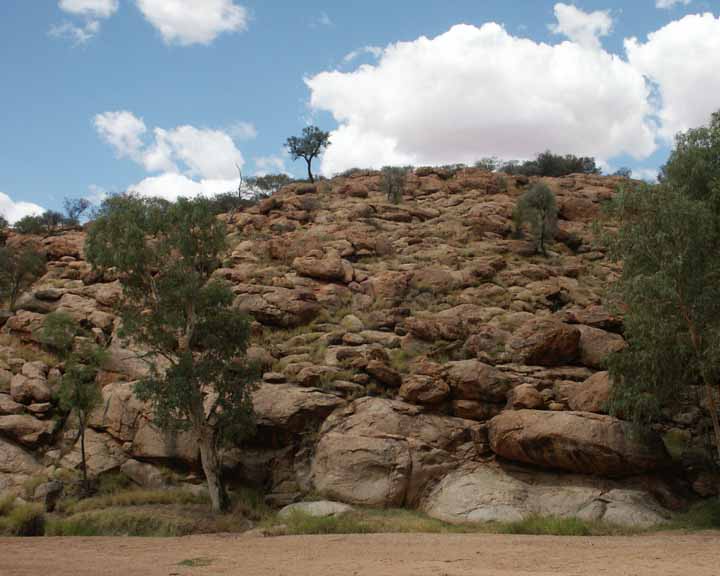
Then it was on to the Royal Flying Doctor
Service. It is a very impressive operation. Basically, it is the health care
system of the people living in the remote outback. It was started by a
Presbyterian minister and, while they get grant money from the government, is a
non-profit organization.
We ate lunch at a local mall. Karen had told us
of a local book store that sold mainly books on Australia. (We'd noticed previously
in the cities here they have specialty book stores. This one was on Australia, but
we've also seen one dealing with nautical maps and others devoted to other
specific topics.) After lunch it was on to the hotel. While all of the hotels we
stayed at were nice, this one was particularly lovely. We opted to catch up with
laundry in the afternoon prior to our outback barbeque. The barbeque was
outstanding. They drove us out of town to a location and gave us a demonstration
of boomerang throwing, provided drinks, talked about the size and life on a
cattle stations (some cattle stations are bigger than some of our states), told
us more about aboriginal life, and then fed us one of the best tasting meals
we've had. All of this was outside. After the meal there was a sing-a-long and
they showed us some of the constellations in the southern hemisphere skies.
Words aren't adequate to describe how great everything was, but topping it off
was the scenery. The picture below was taken from our dinner table. As the sun
set these cliffs/rocks changed colors and one minute was beautiful than the
next.

Day 13, Wednesday, March 15,
2006
Alice Springs-Ayers Rock
A morning visit to experience an Aboriginal “DREAMTIME” TOUR and learn more
about this important native culture from your own local guide before flying to
Ayers Rock. Afternoon sightseeing travels past Uluru (Ayers Rock) to the
magnificent Kata Tjuta (the Olgas, a geological splendor of some 30 brilliant
monoliths. There is a time for a walk to the Olga Gorge before returning to
“Sunset Strip” to stop for a drink as you witness the changing colors of the
Rock. Tonight why not join the totally unique “Sounds of Silence” optional
dinner? [B]
Another glorious and busy day Down Under. After
breakfast we boarded the bus in Alice Springs
and made a brief stop at an outlook over the city. It was a war memorial to the
men and women of the Australia
and New Zealand
who had died in the service of their country. It was a wonderful tribute and
provided a great overview of the city.
From there we went to an area close to airport
for more exposure to the aboriginal culture. We were shown a map where the
different groups lived. Similar to the American Indians of different tribes, the
various Aborigine groups spoke different languages; therefore, couldn't
communicate with one another. While they didn't have the same language, it
appears they have many of the same beliefs and values. In particular, it was
interesting to learn that they put no value on material things. Our driver told
us a story about his wife who was selling an Aboriginal woman's art on eBay. She
told her husband to take $2000 to the artist. He did and, at the artist's
request, drove her around to see some of her relatives. By the time they got
back to the artist's home, he thought she maybe had $200 left. She had given the
rest of it away.
Between talks about Aboriginal culture, we had
the opportunity to purchase paintings from local women. Another interesting
aspect of Aboriginal beliefs came from the explanation of how to go about
purchasing a piece. The Aborigines don't usually like to have their pictures
taken (the reason for that is too complicated to go into here), but they are
willing and it is recommended to photograph the artist and the art that you
purchase. The artist is okay with this because they believe the photograph is
really of their art not them. There also doesn't seem to be the hesitancy for
little kids to have their picture taken. The little girl in the picture below is
obviously not the artist, but seemed to be very happy to be in pictures.
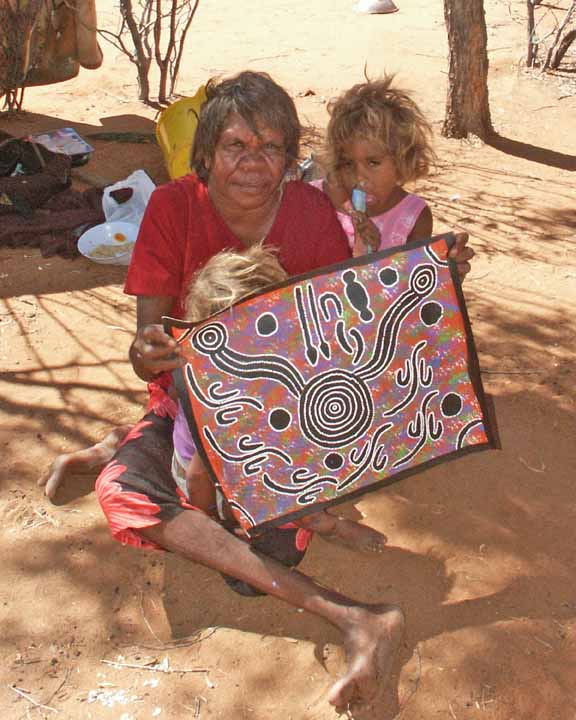
After that we learned about "tucker" - outback
food. There was the opportunity to sample cooked kangaroo tail and live grubs.
Roy
passed on both. Pam said the kangaroo tail tasted like pork, but passed on the
grubs. (She prefers not having to chase her food.) In fact, no one in our group
sampled the grubs.
After that it was on to the plane again for our
flight to Uluru (Ayres Rock). On the flight we were told that the temperature
was 40 degrees Celsius. We struggled with converting it. Roy remembered the formula, but didn't want to
pull out his pad of paper to do the math. We concluded it was going to be hot.
(Having had the opportunity to be at the computer, Roy calculated that 40 degrees Celsius is 104
degrees Fahrenheit) Surprisingly, the 40 degrees was not all that bad. First, as
our friends from Arizona
keep telling us, it is dry heat. Second, there was quite a breeze blowing.
That helped with another problem as well as the
heat. In both Alice Springs and by Uluru there
are flies. These flies aren't really the nasty biting kind like we have up in Wisconsin. But, what they
lack in viciousness they make up in numbers. Most of the people on the tour,
including Roy and Pam, ended up buying nets to put over our heads and faces. It
was not much of a fashion statement, but it was certainly an aid in keeping the
flies from being overwhelmingly bothersome.
After checking into the hotel we drove out to
Kata Tjuta (The Olgas). We caught glimpses of Uluru on the way out to Kata Tjuta
and again while there.

Kata Tjuta was certainly impressive, but there
was something almost magical about Uluru. After going to the observation area
for Kata Tjuta, we drove around Uluru. We stopped a couple of times to get up
close and personal. There are some petroglyphs that we were able to see, but, in
Roy's opinion, they were not as vivid as some of those we
saw at Kakadu.
A tradition has evolved for tourists of
watching sunrise and sunset at Uluru. We don't know how sunrise is done, but
sunset observation is celebrated with champagne and "nibbles." There was plenty
of champagne and nibbles for all. Orange juice, pop, and water were also
available. Pam thought it was really cool partaking in this tradition. We got to
the place where we going to watch the sunset about an hour before actual sunset.
Karen suggested that we take a picture every 15 minutes to so that we could
record the color changes. Of course, for Roy, 15 minutes was far too long between
shots. The problem with taking so many pictures of the same beautiful thing is
that we had to decide which to show. Below is the one that Roy likes best taken well before sunset.
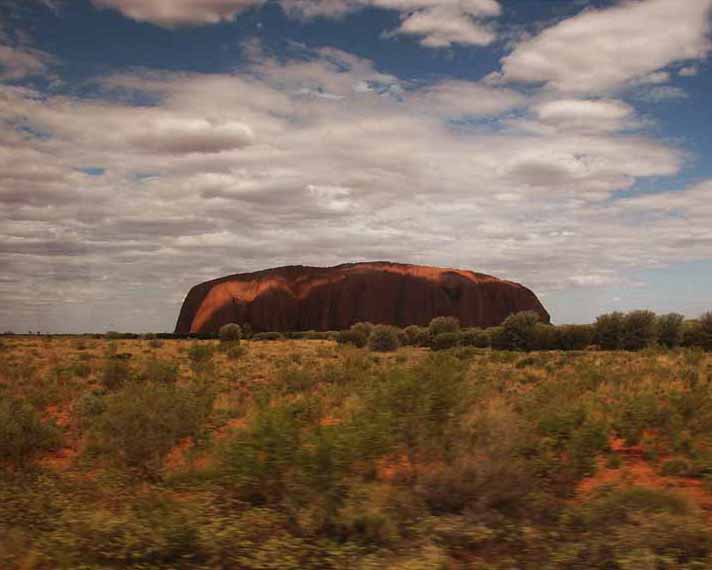
After sunset, it was on to the bus and back to
the hotel. We were quite tired and didn't feel like going out for supper, so we
ordered room service. (It's the first time we have done that as a couple.)
Day 14, Thursday, March 16,
2006
Ayers Rock-Alice Springs-The Ghan
Train
An early morning TOUR around the
base of Ayers Rock before flying to Alice Springs
where a highlight of your vacation begins with a train journey on The Ghan,
offering a fascinating perspective of the Outback. [B,D]
We did not have the early morning tour around
Uluru as we had done that yesterday .Once again Qantus impressed us. It was an
hour flight and they served us a light breakfast/snack and beverage. The flight
attendants were hustling, but they really didn't make us feel rushed.
We did have some time between the flight
landing and the time to board the train. Karen decided to drop us at the local
mall to pick up some lunch. She suggested either eating it there or getting
"take away" and eating on the train.
Roy
was pleased we were stopping there because he remembered that there was an
internet cafe in the mall that accepted laptops. Unfortunately, it was a
different mall in a different town. (It's also getting hard to remember hotel
room numbers.) So, we did souvenir shopping.
Then it was on to the train station where the
picked up "The Ghan" (rhymes with can). It is named in honor of the men and
their camels from Afghanistan
that helped build the initial railroad. We thought it was interesting that
unlike what happened with the Chinese that were imported to help build our
railroads, almost all of the Afghans went home when the railroad was
completed.

As we had never been on a train overnight, we
weren't sure what to expect. We were pleased to find that our little compartment
did have its own bathroom including a shower. (Because of the coziness of the
arrangement and the rocking of the train while in motion, we decided not to use
the shower.)
The scenery on the first part of the trip had a
raw beauty but became rather redundant.
Roy
took a nap in the coach. When he woke up and looked out the window, he asked Pam
if the train had been moving.
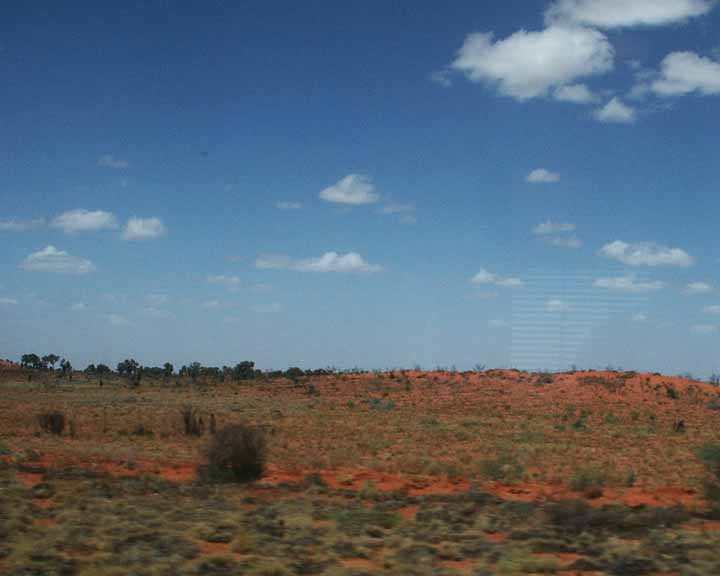
We had dinner at the late seating (of two).
There was a choice of two entrees (appetizers) and three main courses. The food
was very good.
Day 15, Friday, March 17,
2006
Adelaide
Arrive in Adelaide, for a city tour
along the wide tree-lined streets and well-manicured. See Ayers House, the
exotic botanic gardens, and the Festival
Center overlooking the Torrens River. Finish with a visit to the NATIONAL WINE
CENTER, providing a wonderful
opportunity to sample some award winning wines, and learn hands-on why wine
making has become one of
Australia’s fastest growing industries. [B]
We awoke about 6 AM, and then had a nice
breakfast on The Gahn. It was very cool sitting in a railroad dining car
watching the sun rise.

In all honesty, neither of us slept that well
on the train. It was rockier than I expected. We heard comments from people who
were on the train all the way from
Darwin
that the first night was a lot smoother. We arrived in Adelaide about 9:30 and in took about a half
hour for the driver and Karen to get our luggage straightened away.
It appeared that we weren't the only one who
had trouble sleeping. As we were pulling away from the train station, Karen
commented on how special the train ride was and then asked the group how many
were glad that they did it. It appeared that everyone was glad they did it. Then
she followed it up by asking how many would want to do it again. The response
this time once again appeared to be unanimous that no one wanted to do it again.
We did a short tour of the city stopping at a Japanese Garden and outlook giving an overview of
the city. Adelaide
appears to be a very clean city with numerous parks around the center of town.
We checked into the hotel (another luxurious room) around 1 PM. We went to a
local mall within a block from the hotel and grabbed a Subway for lunch and then
went back to the room for a time while Roy took a nap and Pam read. After that we
wandered to another mall that was about 4 blocks away. While the mall we ate
lunch in reminded us of Pikes Market in that there were all sorts of fresh foods
and flowers, the one we walked later was like nothing we had ever seen. It
seemed to us that there were more stores than at Woodfield.
We ate dinner at a little Italian place. Roy had veal Parmigianino
and Pam had chicken Parmigianino. It is the first time either of us have had it
over french fries rather than noodles. (We think we'll stay with the noodles.)
Day 16, Saturday, March 18,
2006
Adelaide
The day is at leisure. Choose from
a great selection of optional excursion
available: a visit to well-known
Australian wineries in the Barossa
Valley, or a full-day trip to Kangaroo Island,
one
of the world’s last unspoiled habitats.
[B]
Today turned out to be our first major
disappointment with the trip. We had signed up for a tour of Kangaroo Island.
The trip required being picked up early from the hotel, being driven to a
transfer point, being driven about 2 hours more in a bus, then taking a 45
minute ferry ride to the island, taking the tour, and then doing the same
process in reverse for the return trip. The estimated time of return was 10:30
PM. Everything happened exactly as planned except the things that we saw on the
tour were not the things listed in the description. What made it even more
frustrating was that some of the people who signed up from our Globus tour for
the same tour as we did got the tour of the island that was as described. To put
it simply, Greyline/Sea Link put us and another couple on the wrong tour. We
were very disappointed that we missed out on what we thought we would see and
do.
We did see how honey is made (processed - the
bees do the making) and then had lunch. We then went to another wild life park.
As Kangaroo Island
is part of Australia, they
had koalas and Roy
found it necessary to try to capture their cuteness. We did get to pat these
little darlings and also feed kangaroos that are indigenous to Kangaroo Island. The bus driver commented that
there are too many koalas on the island and suggested that each tourist
take one home. That would help the overpopulation of koalas!
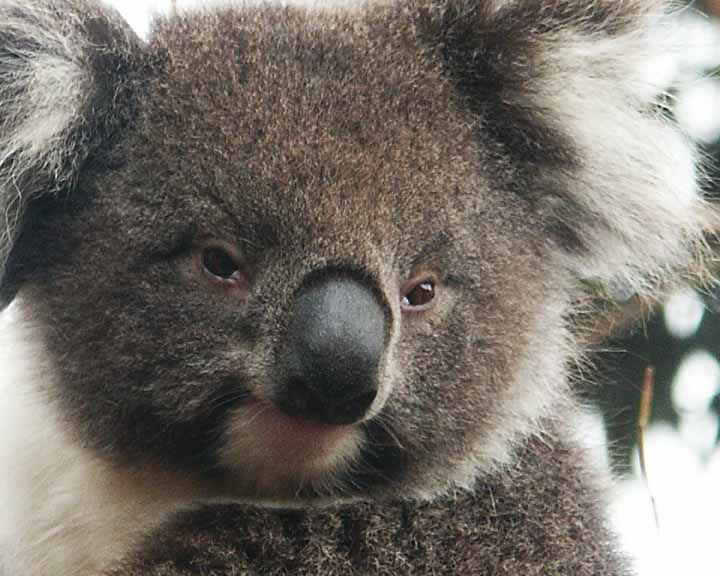
After the wild life park, it was to a beach
where we were told about the Australian Sea Lions (they are really seals). This
was the one thing that we did that was on the tour we were supposed to
have been taking and it was outstanding. There were lots of sea lions. While
most of them were soaking up the rays, many of the others were doing enough to
keep the viewing interesting and the picture taking worth while. The pup shown
below captured our attention and hearts. He was very energetic, curious and
fearless. He got to within about 20 feet of our group and was studying us as
hard as we were studying him/her. Roy
took a ton of pictures of our little friend, so it shouldn't be a surprise if
the picture below is replaced at some point with a collage of our little buddy.
(Or, we may end up with this picture and a collage.)

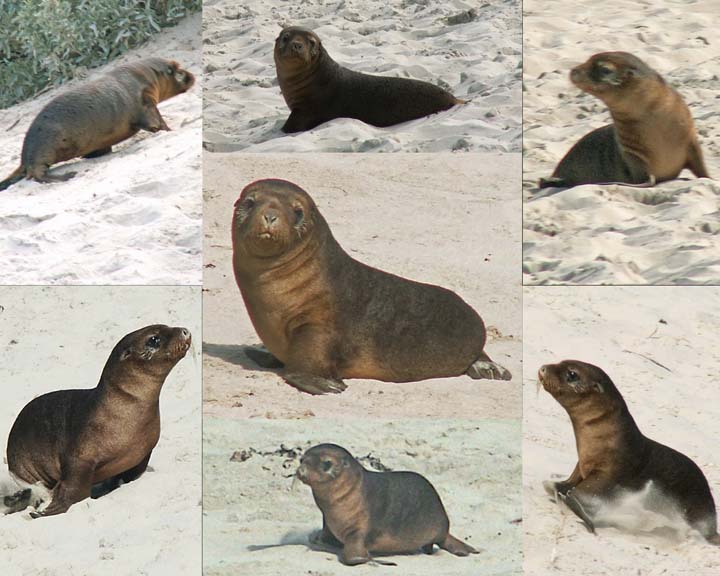
After that it was listening to a gentleman talk
about pelicans and watch him feed them. Then, it was time to start the trek back
to the hotel.
Day 17, Sunday, March 19,
2006
Adelaide-Melbourne
Today fly to Melbourne,
Australia’s second largest city. Today’s tour
includes landmarks such as Parliament House and the Shrine of Remembrance, a
tribute to Australia’s war heroes. Visit
beautiful FITZROY
GARDENS and then drive
past the lush Royal Botanical Gardens. You’ll soon discover the differing
architectural influences of this city as you see the Victorian Arts Centre and
other buildings of significance. Later this afternoon, you can join the highly
recommended optional excursion to see a penguin parade. [B]
Another pleasant flight with Qantus this
morning. When we arrived in Melbourne,
a challenge was added to our touring of the city. The Commonwealth Games are
being held at this time. To make things even more challenging for Karen and the
driver, today was the day of the marathon. Naturally, it was run on the city
streets. We did spend time looking at and photographing St. Patrick's Cathedral,
a very impressive building and garden. It was only about two blocks from the
Fitzroy Gardens, which were lovely and also is
the site of the restored home of Captain James Cook. We had lunch at the Royal
Botanical Gardens before going to our hotel. The room again was quite luxurious.
We commented to each other that it was almost a shame how grand these rooms are
when we spend so little time in them.
We had a little time to rest before we were
picked up for the optional tour to see the fairy penguin parade. This was
something Roy had heard of when he was in Melbourne for business. Once he told Pam about
it, it became "a must" for this trip. It requires about a 2 hour drive southeast
of Melbourne to get to the National Preserve on
Philip
Island where every night
around 8 o'clock (dark) the penguins that have been at sea all day feeding come
back to their nests. Usually, it starts with a few and then hundreds of them
come.
Unfortunately, it was molting season so we did not get to see the hundreds
come out, but we did see a few.
We had been given the suggestion to either sit
up front or in the very back. Since we weren't among the first to get there, the
front was out of the question. So, we opted for the back. As we waited for the
penguins, we started hearing strange trilling sounds. They grew louder and
more "voices" joined in. When a ranger walked by, we asked her about it. She
told us that it was penguins making their happy night talk. It was wild!!
The time came for us to head back to the bus
along the boardwalk that had been built by the park with soft lighting on the
outside. We were surprised to see many, many of the little friends (these
penguins are only about a foot tall) out of their nests/burrows. Some were just
standing, others were walking right beside the boardwalk, and the penguin
talking was even louder than when we were waiting for them. It was altogether
cool!

This photo is a cheat - it was taken at the
aquarium in Sydney.
Photography of any kind is not allowed at the penguin park and we were pleased
to see it being enforced. Two suggestions if you are animal people like us and
decide to go to the park (which we recommend): First, remember this is wild
life. It is not a scripted show, so if the hundreds don't show up on time don't
be too disappointed. Second, bring warm clothes. Even though it was a beautiful,
warm fall day in town, at the park it was so cold that we ended up getting a
fleece top for Pam.
Day 18, Monday, March 20,
2006
Melbourne
Full day for you to explore on your
own. Perhaps join our optional full day tour that takes in views of Australia’s
most breathtaking and unspoiled coastal scenery on the Great Ocean Road,
including unusual rock formations such as the Twelve Apostles adorning the
shoreline. Or, for a unique dining experience, join an optional outing on board
a historic tramcar restaurant as it winds its way through the streets of Melbourne, or dine with the locals on trendy Lygon Street . [B]
It was another early start but was worth
getting up at any time for the day we experienced. We opted to take the Great Ocean Road tour. A large number of
our tour went with us and most importantly Karen. She made the day by suggesting
we move to the other side of the bus. We were one of the first on the bus and
had settled ourselves on the right side, top of the double-decker bus when she
came up and suggested we move to the left side. As we traveled along, we found
that just about all of the significant views were on the left side. Of course,
you could see them from the right, but the more unobstructed views were on the
left.
After driving a couple hours north of Melbourne, our first stop
at a surfing beach was quite impressive, and there were a number of
surfers testing their ability on the waves. What was really surprising was the
beautiful restroom facility. The bus driver prepared "morning tea" there.
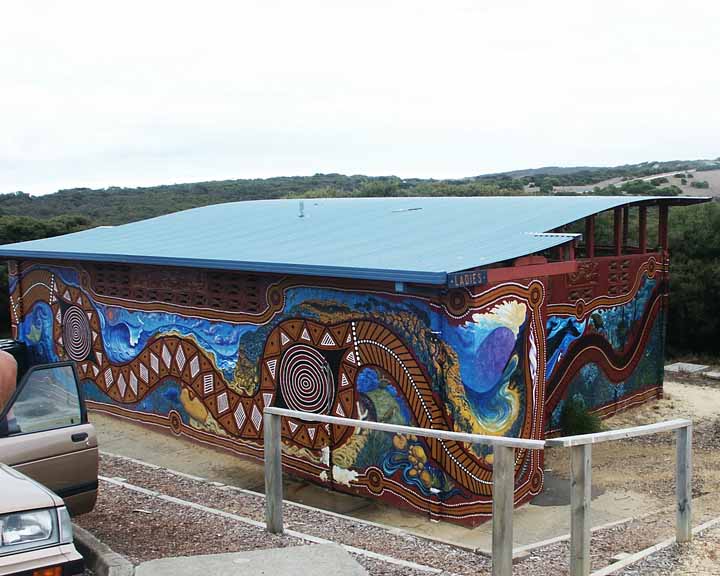
You have to admit there aren't many outhouses
that look like this in the USA.
From there it was on to another overlook that
was even more impressive, but Pam missed the hard bodies of the surfers.

From this point it was on to Apollo Bay
for lunch. On the way, we went through a forest area where the driver told us
he, at times, has spotted koalas in the wild. Sure enough, we saw a couple doing
what they normally do - sleep.
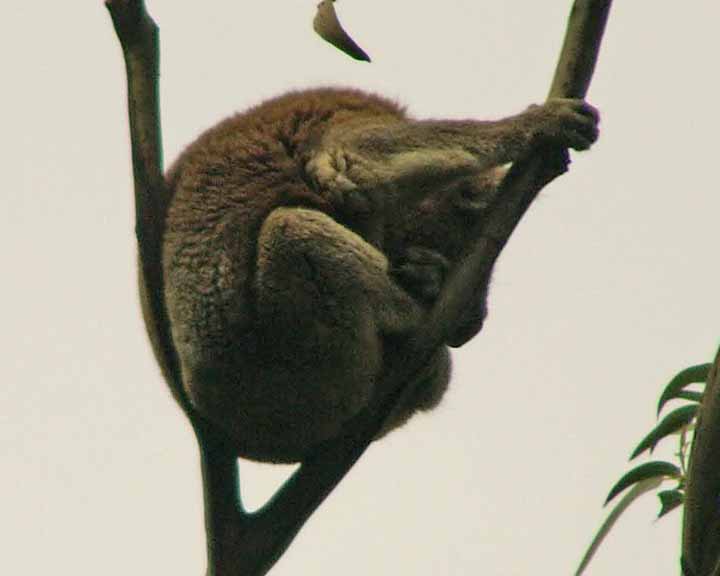
Apollo
Bay was a
cute little town. A couple of places to eat had been recommended. Six of us
opted for George's, a little place with most of their tables on the sidewalk in
front. We found picnic table type seating for six of us and went to see what was
on the menu. Pam and I chose the fish and chips. Each of us received a gigantic
piece of fish plus fries and salad. The fish was outstanding, a very close
second to Eddie's in Arlington Heights.
From there it was on to the highlight of the
tour - The 12 Apostles. Actually, there were only 12 Apostles here for a brief
period, it started out that there were 18 of the monoliths. Last year, one of
the 9 remaining crashed into the ocean. Pam talked Roy into taking a helicopter flight over the
area. Roy
apologizes for anyone looking at this on a slow internet connection, but we had
a hard time deciding which photos could be left out. (Believe us, this is not
all that he took.)
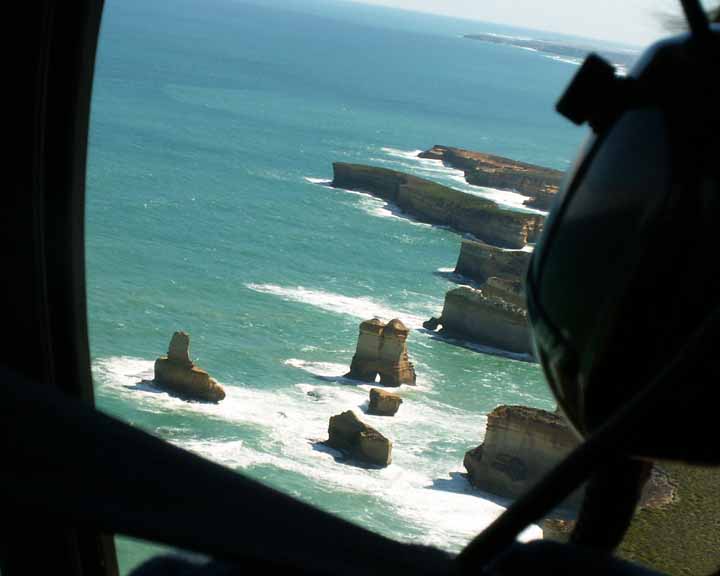
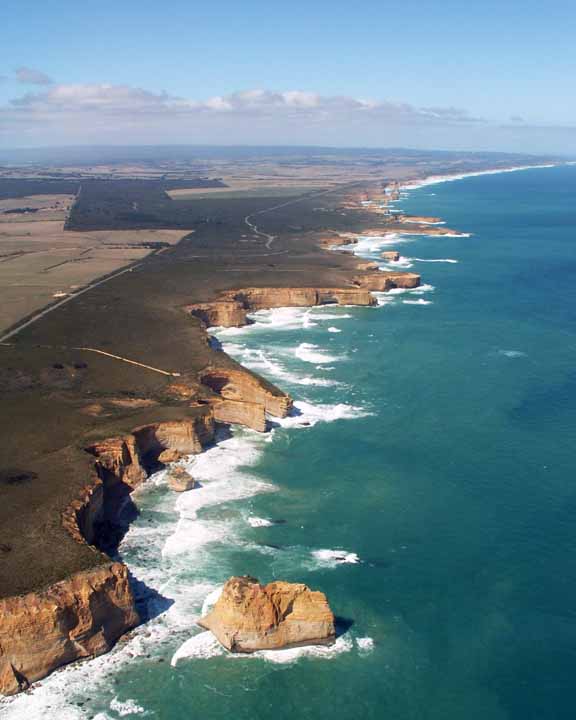
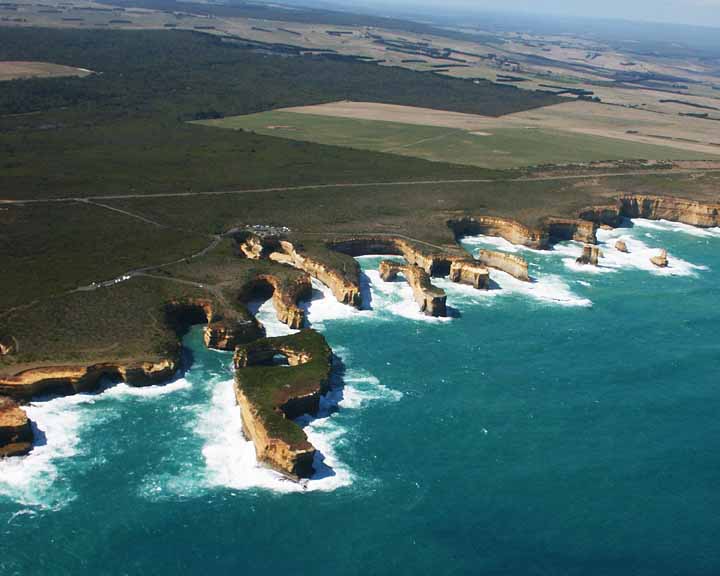
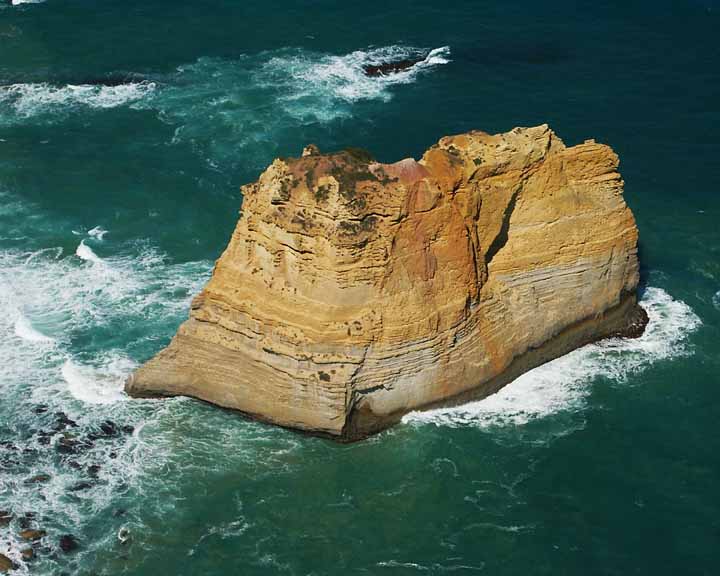
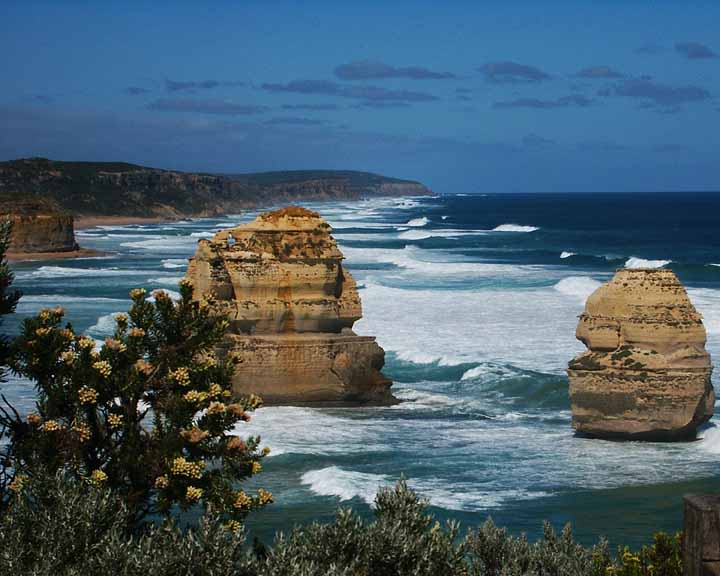
From the Twelve Apostles we moved on to
overviews of monoliths named Razorback and
London
Bridge. They, too, were
beautiful beyond description and, by appointment, Roy will show you pictures of those as well,
but in order to keep downloading time reasonable, we've decided to stop with the
pictures for this day.
After the final monolith viewing, it was a two
and a half hour ride back to the hotel. The bus was equipped with video screens,
and the driver showed a movie for the ride back since it was getting dark. We
grabbed a quick bite with some of our new friends and then slept like logs. What
a perfect day!
Day 19, Tuesday, March 21,
2006
Melbourne-Hobart
Fly to Hobart, Tasmania, home of
the infamous Tasmanian Devil. [B]
We were on the bus at 9 AM for a try at seeing
some of the things that we couldn't see on Sunday because of the Commonwealth
Games Marathon. One of the tidbits that we picked up on this tour was that, by
law, one third of the land
of Melbourne is devoted to
parks. Because of traffic problems and needing to get to the airport, we still
couldn't see everything, but we did get to see the Shrine of Remembrance. What a
moving experience. It started as a tribute to the Australians who served in WWI,
but WWII and other conflicts have been added. Can you imagine something this
size in middle of an American city?
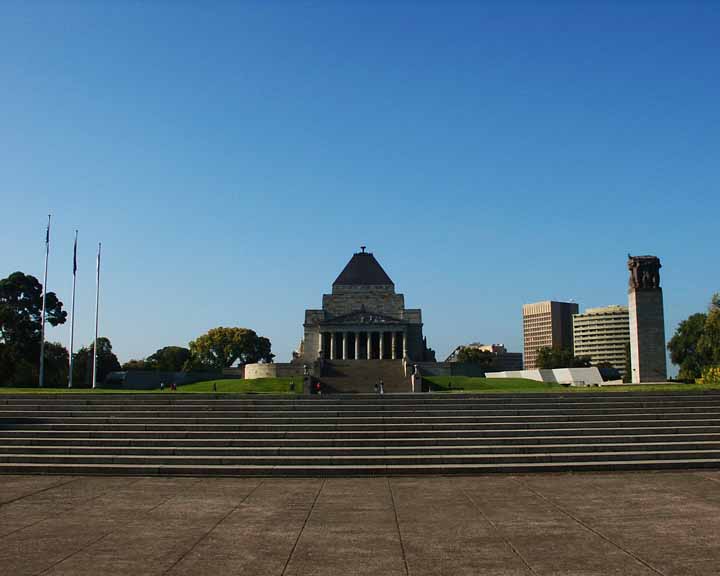
There was a very moving ceremony that takes
place every half hour that adds to the uniqueness of the memorial.
Then it was on to the airport and our first
experience with Jetstar. It is the Australian equivalent of Southwest Airlines
only they've gone a couple of steps farther. For one thing, if you want a cup of
coffee on the flight, you pay for it. It wasn't that bad. The seats were
comfortable, and we got to Tasmania
safely. Once in Tasmania
we took a short tour of the city and then went to our hotel. It was decided that
this was going to be the time we did our last washing of clothes on the trip. It
seems a number of our tour friends had decided the same thing. That meant that
Pam got to spend the afternoon in the laundry room, and Roy got to spend his time
catching up on the photos and this journal. The hotel we're in is not right
downtown as many of the others have been. So, we ate dinner in the hotel. Before
you feel too sorry for us, the picture below is the view out of our hotel
window.
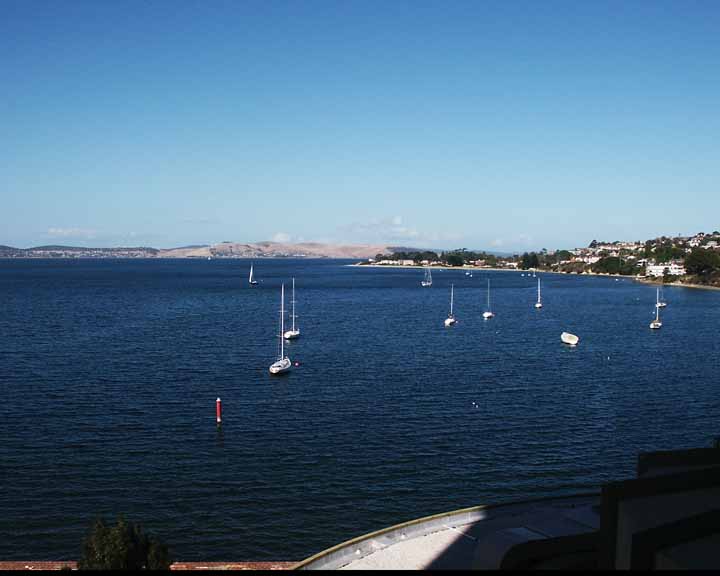
It's a tough life, but we can handle it.
Day 20, Wednesday, March 22,
2006
Hobart.
Excursion to Port Arthur
Today’s tour of the scenic
Tasman
Peninsula features the
blowhole, the Devil’s Kitchen, and the Tasman Arch coastal formations. Visit Port Arthur, where the
first convicts arrived in the 1830s. A guided tour of the PENAL SETTLEMENT shows
you the ruins of the four-story penitentiary, and the model prison… grim
reminders of Australia’s
days as a penal colony. Also included is a short stop at a nearby SANCTUARY to
see the famous Tasmanian Devil, a rare marsupial wolf. [B]
Once again we had a beautiful experience today.
We started our tour with a stop at the Tasman National Park Lookout. We were
rewarded with some more of the spectacular sights we have come to expect.
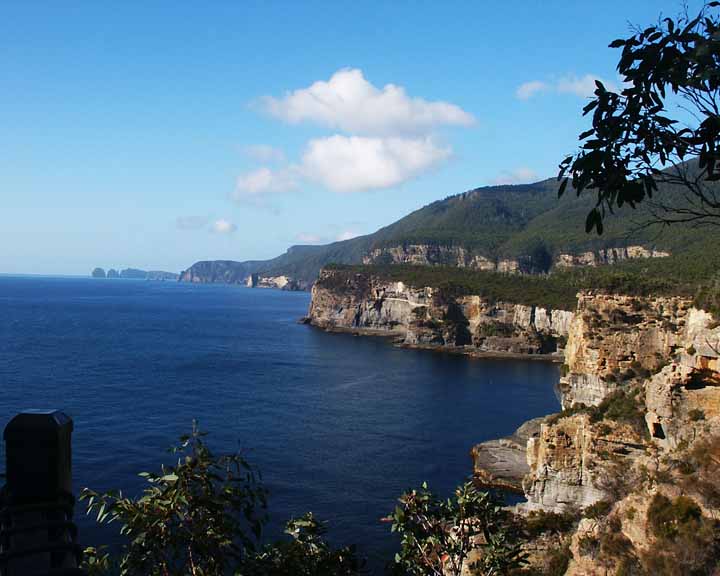
From there we went to the sanctuary for the
Tasmanian Devil. They have just been placed on the threatened list because of a
type of cancer affecting the animals in the wild. It is particularly interesting
because it appears to be transmitted by contact. The "Tassies" in the sanctuary
are not threatened because they do not have contact with those in the wild.
There were other animals in the sanctuary, but Roy decided he wanted to try to get a good
picture of these unique animals, because so few places have them. It was a
challenge because they were in constant motion. The picture below may make them
look as cute and cuddly as we saw them at the Australia Zoo in Brisbane.
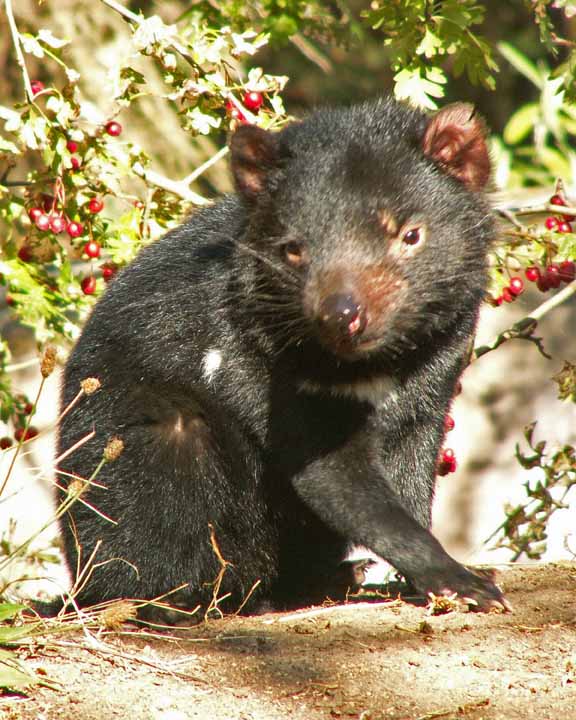
However, the picture below shows they don't
always play well with others.
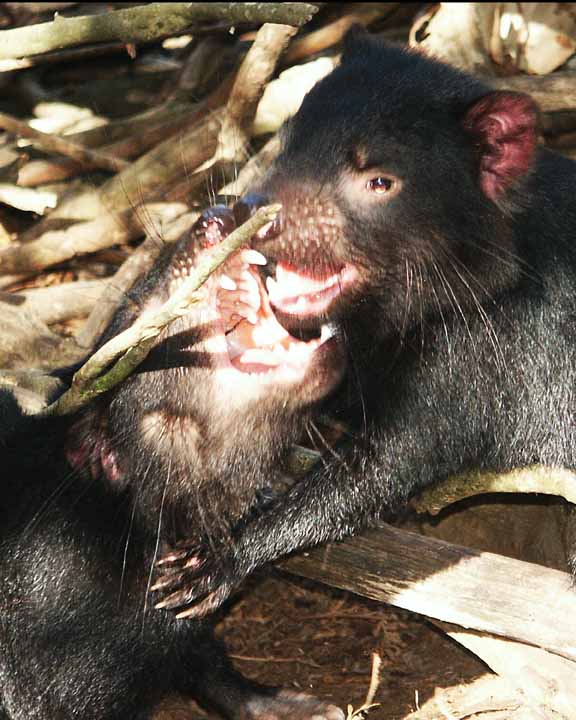
From the sanctuary, it was only a short drive
to Port Arthur, the penal
colony that is being restored to show what life was like there. We commented
that we had to pay bunches of money to come visit beautiful Australia, but
the convicts were sent here. They indeed did have a magnificent view, but having
heard when went on in the prison, it's unlikely they really appreciated it. We
had a tour by a wonderful guide who seemed to bring the history of the place to
life.
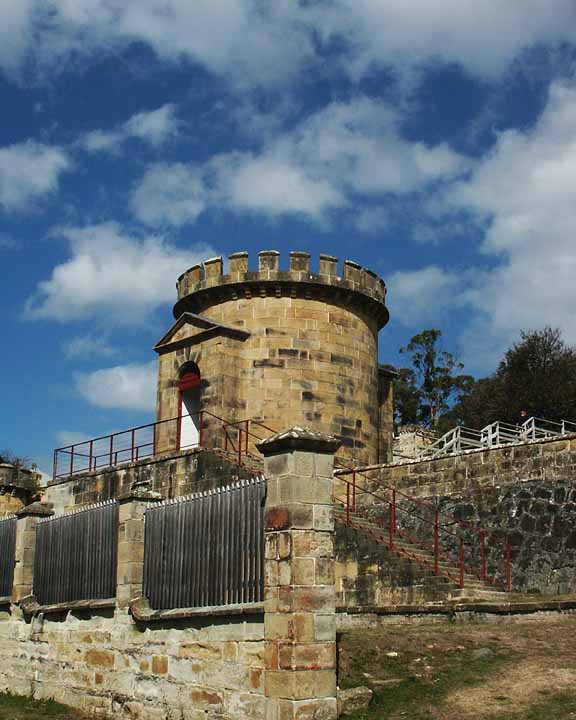
After our time in Port
Arthur, we returned to our hotel in
Hobart, enjoyed an early dinner, and then prepared for
our very early departure tomorrow morning.
Day 21, Thursday, March 23,
2006
Hobart-Auckland
Today fly across the Tasman Sea (via Melbourne)
to Auckland, New
Zealand.
We had to be on the bus at 4:45 AM this morning
to go to the airport. The flight from Hobart to Melbourne included a light
breakfast although the flight was just a little over an hour. We then had about
a 4 hour layover in the Melbourne
airport. The three hour flight to
Auckland
included not only a hot meal but complimentary wine as well. Not bad for economy
class!
Day 22, Friday, March 24,
2006
Auckland
Sightsee in this attractive city
known as “City of Sails”
situated on an isthmus between two magnificent harbors. From the top of Mount Eden
you have a stunning view of Auckland as well as Kangitoto Island, the volcanic cone which dominates
the inner harbor. Today’s highlight is a visit to KELLY TARLTON’S ANTARTIC
ENCOUNTER where you will see colonies of penguins playing in real ice and snow.
Then travel beneath the ocean to see a giant stingray and moray eels, and come
face to face with the awesome predators of the deep – sharks. [B].
This morning started with a bus sightseeing
tour of Auckland. We visited an
overview site and saw many lovely parks. One of the consistent things about the
views of this beautiful city was the ever present Sky City Tower. It is the tallest tower in the
Southern Hemisphere. People have the opportunity to be put in harnesses and jump
off the building. Kiwis have many bungee places available, too. We chose to keep
our body parts in their present arrangements!
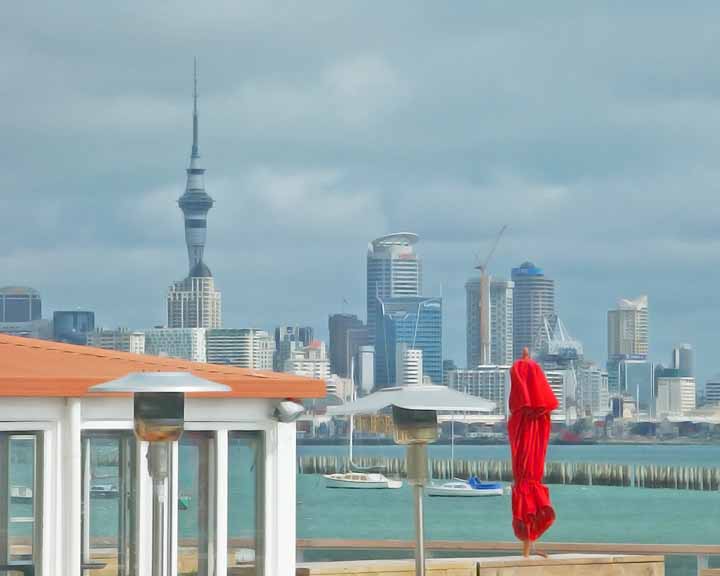
The last stop of the city tour was at Kelly
Tarlton's Antarctic Encounter. It is a great aquarium that specializes in
King/Emperor penguins. They have a very successful breeding program. You might
notice that there is one brown/young penguin in the picture below.
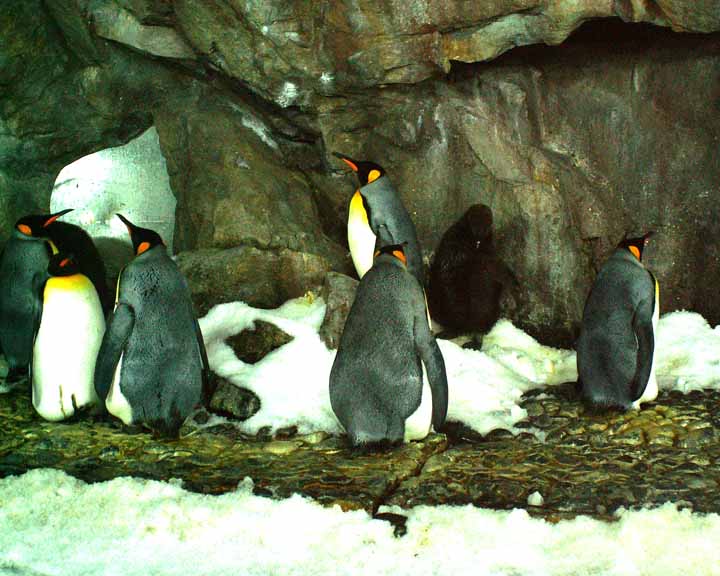
After the city tour, we grabbed a sandwich and
were picked up for our rainforest tour. The first stop was Arataki Cultural
Center where we learned a
little more about the Maori culture. We also had a tremendous view of the Manukau Harbour. As usual, a photograph cannot do
justice to the beauty that is there, but hopefully the picture below will give
you a hint.
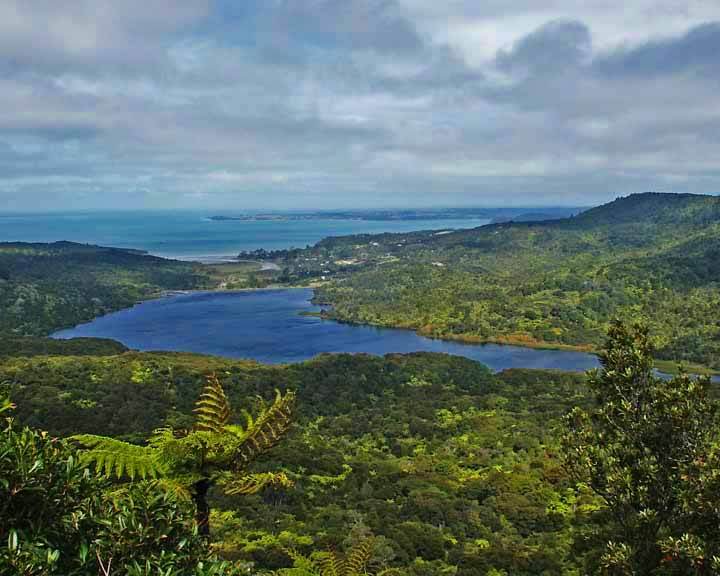
From there, we visited a beautiful waterfall
and then to a black sand beach. Roy
found it fascinating that the sand was magnetic. He is concerned about getting
old, because he can't remember which iron oxide is magnetic. At least he wasn't
too feeble to recognize the beauty of the formation in the Tasmanian Sea
shown below.
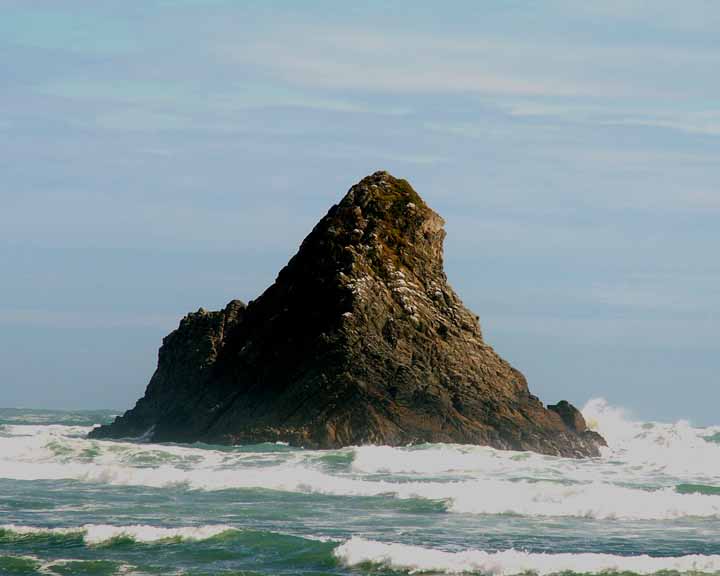
After the beach, there was a short walk in the
rainforest. It didn't rain. That's not a complaint! We were prepared for rain,
but our preparation apparently was enough to keep us dry. What helped make this
optional tour so fantastic was the guide. It helped that she had a great name,
Pam, but her enthusiasm and knowledge of what she was showing us made the
afternoon a great joy!
We got back from our rainforest in time to be
dropped off at our optional dinner and tour of Devenport, a suburb of Auckland. It is a very wealthy suburb. One of
the reasons may be the view at sunset.
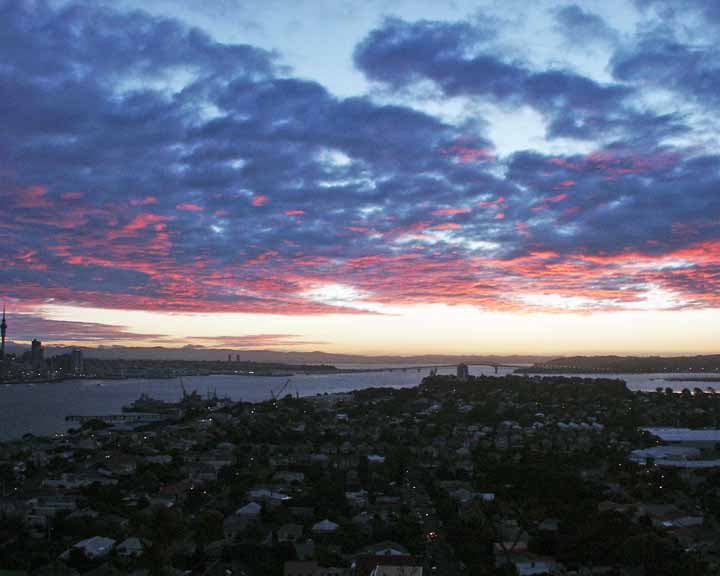
Day 23, Saturday, March 25,
2006
Auckland-Waitomo-Rotorua
Leaving the “City of
Sails ” travel through the green pastoral region of Waikato to the
famous WAITOMO GLOWWORM
CAVES, which has attracted
visitors for over 100 years. Experience a guided tour through the limestone
chambers and passages of the caverns. Enjoy a silent boat trip through the
glowworm grotto as you glide quietly beneath the lights of thousands of
glowworms suspended from the cave ceiling. In the afternoon continue over the
Mamaku
Ranges to Rotorua. On
arrival experience TE PUIA, Rotorua’s most prominent thermal area with New Zealand ’s
largest geyser, boiling mud pools, and silica terraces. Enjoy a traditional
HANGI DINNER this evening, followed by an authentic MAORI CONCERT. [B,D]
We started the day with a lovely bus ride
through the countryside of the north island
of New Zealand before reaching the Waitomo Glowworm
Caves.
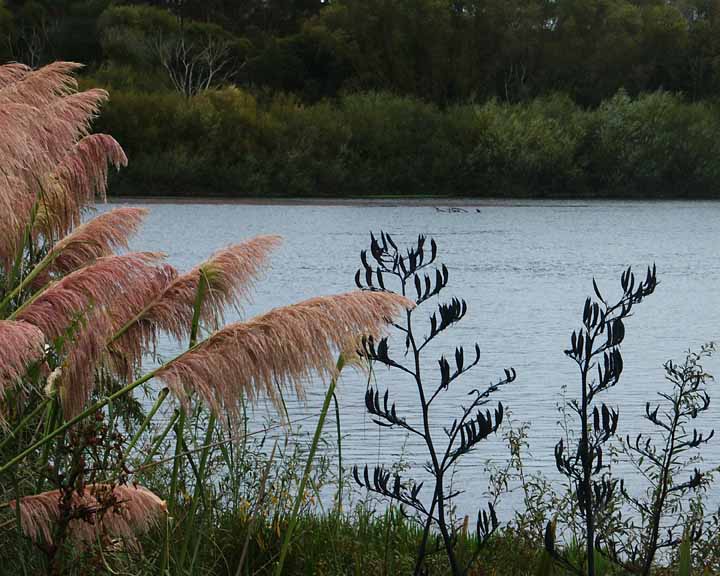
We spent some time exploring the caves
(beautiful) and being told a little about the glowworms before getting into a
boat to see them. It wasn't a long boat ride, but it was fascinating to see
them. Roy had expected to see
little strings of light, but instead it was points of lights. It was like
looking up into a clear, starry night. The glowworms suspend sticky "strings"
from their bodies to catch their food. The glowworm is a larval phase, the
second of four stages. We were asked to be very quiet while we floated along
watching the glowworms. Everyone cooperated!
After a stop for lunch, we had more scenic
travels as we made our way to Rotorua. We were fortunate to have a really great
guide of Te Puia, a park showing Maori culture and the geothermal activity. The
cultural part of the park was called "Te
Whakarewarewatangaogaoteopetauaawahiao." While our guide could pronounce that
with ease, she also provided a translation: The gathering place for the war
parties of Wahio. (But, I bet you knew that already.) Then it was on to the
geothermal area. Actually, you could tell that you were in the area all along
because of the slight sulfur dioxide aroma in the air. Roy found trying to photograph the geysers
challenging, but finally got something that sort of shows the activity.
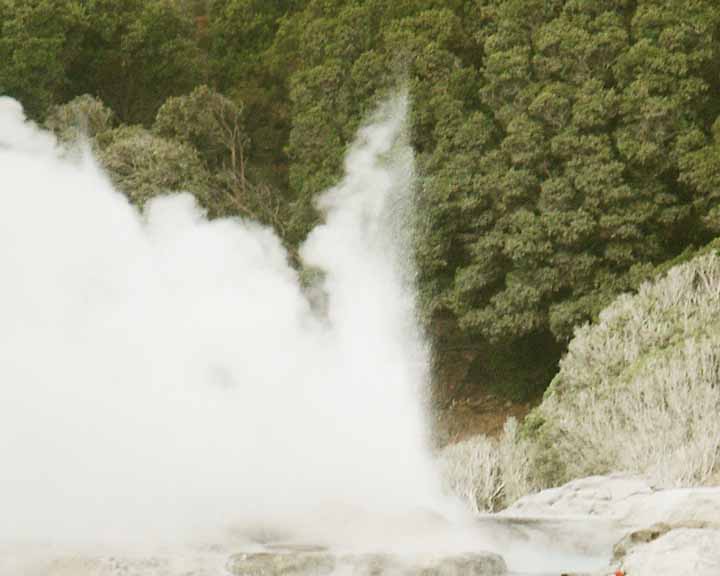
After visiting Te Puia, we went to the hotel
for a short rest and then out to a Hangi dinner. The Hangi dinner is the Maori
equivalent of a Hawaiian luau. The food is even cooked the same way - in a pit.
The food was very good. Roy
was happy not to find the equivalent of poi in what he selected.
Following the dinner, there was entertainment
consisting of Maori songs and dances. It was quite fascinating. Toward the end
of the program there was an opportunity for the ladies to learn one of the Maori
women's dances using poi balls on a long string. No women from our group chose
to participate in that. (Pam pictured the long string wrapped around her neck
instead of twirling in a coordinated fashion and decided not to volunteer.) Then
the men were given the opportunity to learn to do the Haka - the Maori war
dance. It appeared that no one from our group was going to participate.
Roy
figured that since he had part of the dance down pat already, he'd show the rest
that our group was capable. In case, you don't remember, the Haka is that dance
where, among other things, the Maori men stomp there feet, bug out their eyes
(that's the easy part for Lobenhofers), and stick out their tongues. After
completing this exhibition, Roy
was very happy to learn that Don, a gentleman on the tour who has been doing a
lot of video taping, left early.
Day 24, Sunday, March 26,
2006
Rotorua-Queenstown
This morning visit the AGRODOME to
learn more about one of the country’s major industries-sheep. Then onto RAINBOW
SPRINGS, home to rainbow trout and the flightless kiwi bird in its nocturnal
“Kiwi House.” A flight takes you to Queenstown in the South
Island , home base for discovering every type of adventure sport
imaginable. After arriving see the sights of this popular resort town, nestled
on the shores of Lake Wakatlpu
and surrounded by the rugged peaks of the Southern Alps.
This evening why not take our optional dinner at the top of Bob’s Peak on
Queenstown’s Skyline Gondola for breathtaking panoramic views while dining in a
relaxed atmosphere? [B]
The first stop this morning was Rainbow
Springs. One of the primary functions of this facility is the protection of the
Kiwi. Many of the native birds of
New Zealand are flightless. That was fine until
man started bringing in many non-native species of animals. While young, the
Kiwis are vulnerable to many of these animals and their number has been
declining. Kiwis are nocturnal and, therefore, very difficult to photograph.
Rainbow Springs had many wonderful habitats in
rainforest settings. Roy
found a pair of Mute Swans of particular interest.
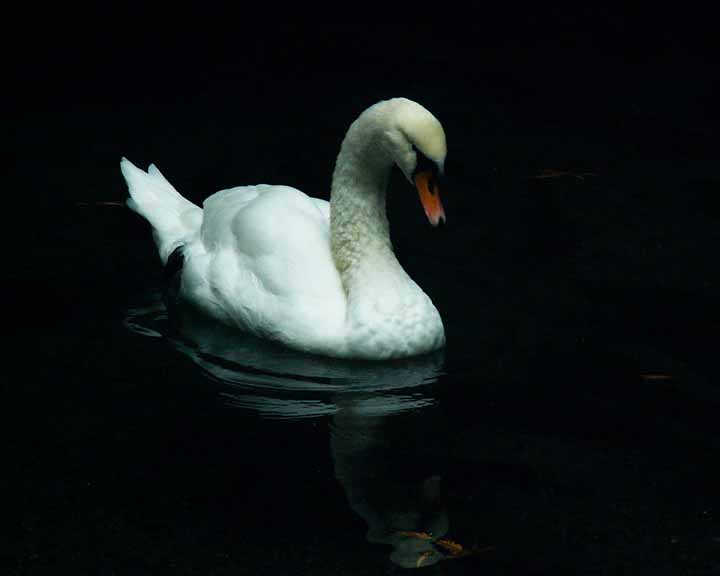
After Rainbow Springs, it was on to the
Agrodome for a very humorous demonstration of the different types of sheep, how
the sheep are sheared, and how dogs are used to herd them. It was interesting to
learn that there are basically two types of dogs used for sheep herding. One
does not bark at all; it uses eye contact only. We had the opportunity to touch
19 different kinds of sheep, some with impressive horns, particularly the
merrino.
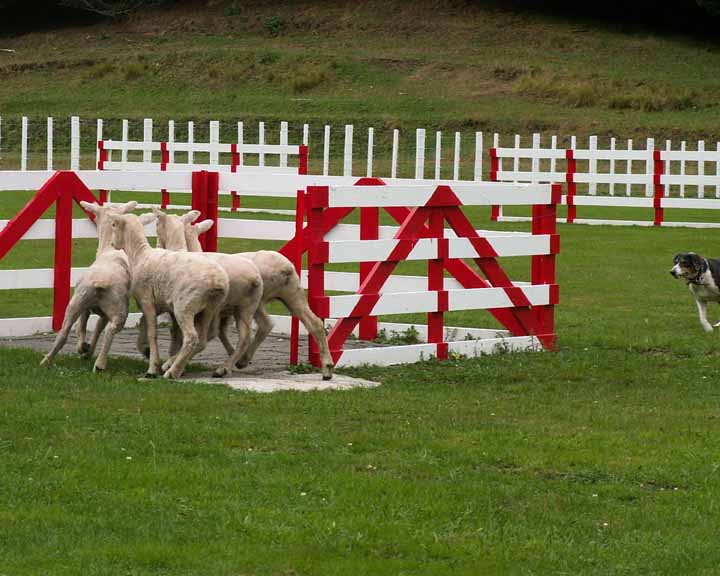
Then it was on to the airport in Rotorua for
our flight to Queenstown. This was our first experience with New Zealand
airports - very cool - no metal detectors or anything. The flight was
interesting. It was Pam's first flight on a prop plane in quite some time. She
likes jets better.
Upon landing in Queenstown, we noticed the
difference between the south and north islands immediately. The south has the
mountain majesty while the north was more of the rolling hills. We took a cruise
on the TSS Earnslaw a steamship built in 1912. We docked for a fabulous dinner
at the Walter
Peak
homestead. Not only was the food wonderful, but the views were outstanding.
After dinner, there was another sheep shearing and dog handling demonstration.
This gentleman shared more details about how to shear a sheep as well as
training the dogs. The return trip on the steamship featured a sing-a-long of
old tunes.
Day 25, Monday, March 27, 2006
Queenstown-Milford Sound
Today journey into FIORDLAND NATIONAL PARK through the Homer Tunnel to Milford. Boasting of some
of the most breathtaking scenery in the world, this region of New Zealand has
the elite status of belonging to the World Heritage Parks, Cruise overnight on
the fiord with sheer rock walls rising thousands of feet from the water’s great
depths. Dinner tonight is on your Milford Sound Cruise vessel. [B,D]
The bus didn't leave until 10:00 giving us an
opportunity to sleep in, but we really didn't. We walked around Queenstown a
little before the bus was ready to depart. It was about a two and a half hour
drive from Queenstown to Milford Sound. It certainly was a beautiful drive. On
the first part of the drive, one of the things that caught our attention was how
the clouds seem to hang in one place on the mountains. It looked as though they
were painted in place.
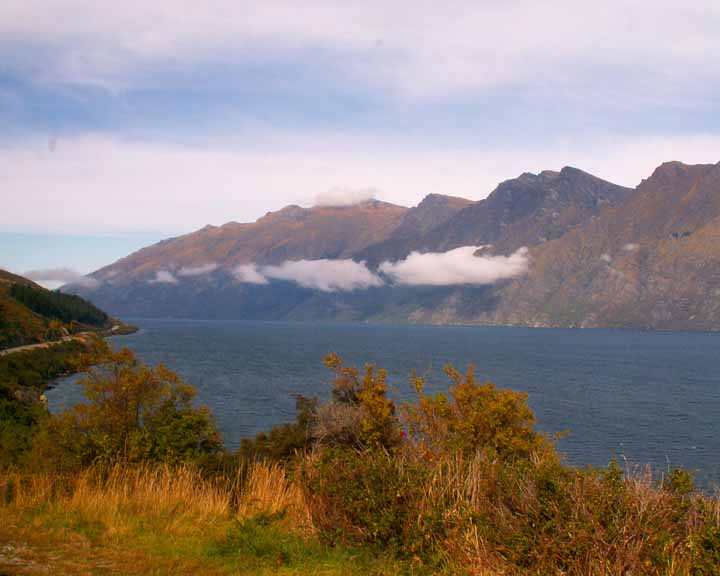
The scenery was at times rolling pastures with
mountains in the background. Other times, we got closer to the mountains as
shown in the picture above. As we rode along, we expected to see
sheep, and we weren't too surprised when we saw some good sized cattle herds,
but we didn't expect to see large red
deer herds. They are a viable farm product here; used for
their hides and meat.
The scenery changed once we went through the
Homer Tunnel and entered the
Fiordland
National Park. Gone were
the rolling hills, the mountains were everywhere.
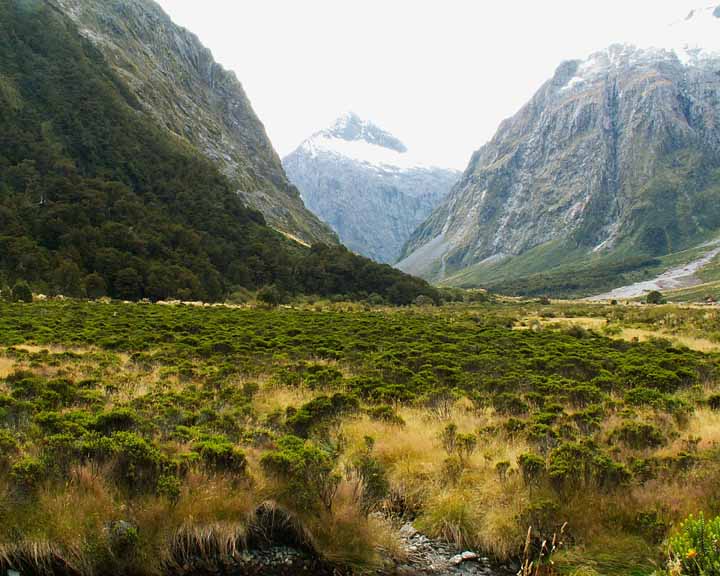
We boarded the little cruise ship in the late
afternoon and sailed to the middle of Milford Sound. They provided us the
opportunity to travel around
Harrison
Bay in a tender with a
naturalist. We learned some fascinating things from Ree, our guide. She told us
that New Zealand
is right over the meeting of two tectonic plates and that there is an earthquake
about every hour; however most are so small they aren't felt. It has been about
40 years since a significant one. Another thing we found fascinating was that
because of this coming together of the two plates these mountains are actually
still growing.
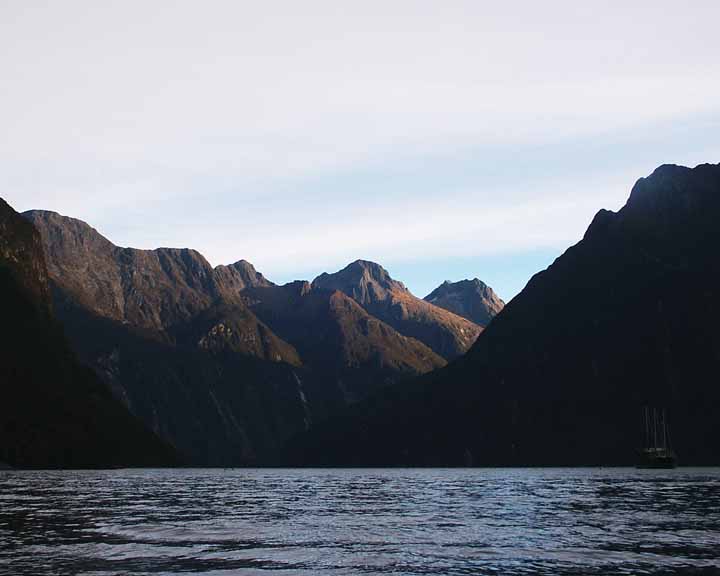
Of course, such a day would not be complete
without a beautiful sunset.
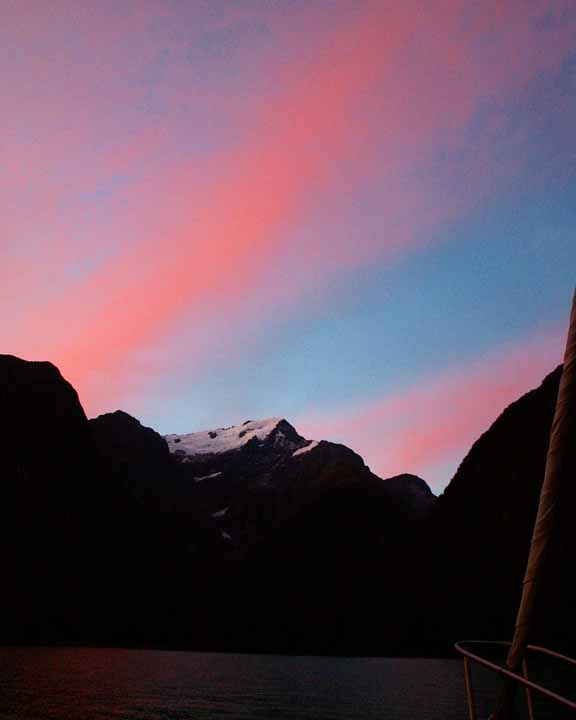
Dinner was buffet style on board and was quite
good. Our cabin was certainly more spacious than on "The Ghan" train, and we had
a restful sleep (no rocking and rolling that we experienced on the train).
Day 26, Tuesday, March 28,
2006
Milford Sound - Queenstown
After
disembarking your cruise, return to the popular resort area of Queenstown. This
afternoon will be at leisure for your own discoveries. Your Tour Director will
have suggestions to help plan the remainder of your day. [B]
One of reasons for staying overnight in Milford
Sound was to be able to go where it meets the Tasman Sea.
We had a very fortunate experience after breakfast. Occasionally, cruise ships
come into Milford Sound in order to unload passengers for special experiences.
We met a Princess ship coming in as we were heading for the
Tasman Sea. We were surprised to learn that it is so tall that it
cannot fit under the Sydney
Harbour
Bridge.
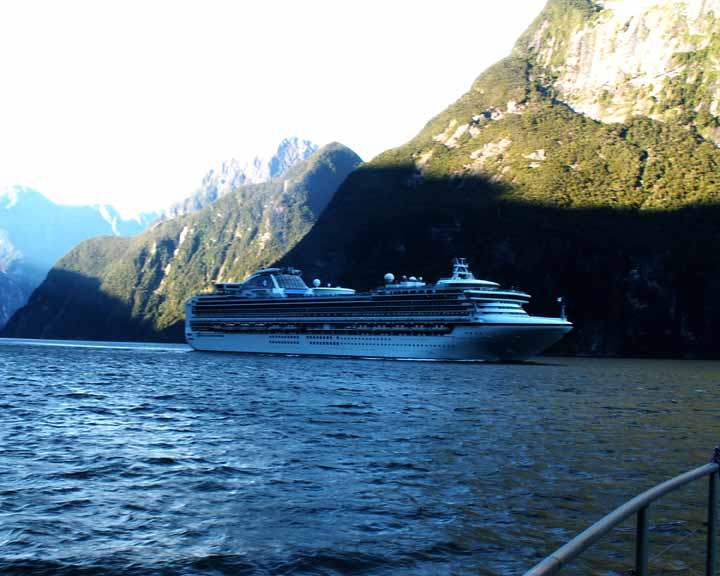
We didn't really think too much about it at the
time other than it was kind of neat to see such a big ship which didn't seem so
big when compared to the surrounding mountains. We did make it to where Milford
Sound and Tasman Sea meet. It is denoted by the
little point of land shown below and, especially in the morning, is quite windy.
It seems the cold glacier water of the sound meeting the warmer Tasman Sea causes some fierce winds. According to the
captain of our little ship, this morning they weren't too bad. They were only 42
knots. (For those, like us, who don't know what that means, it is almost 50
mph.)
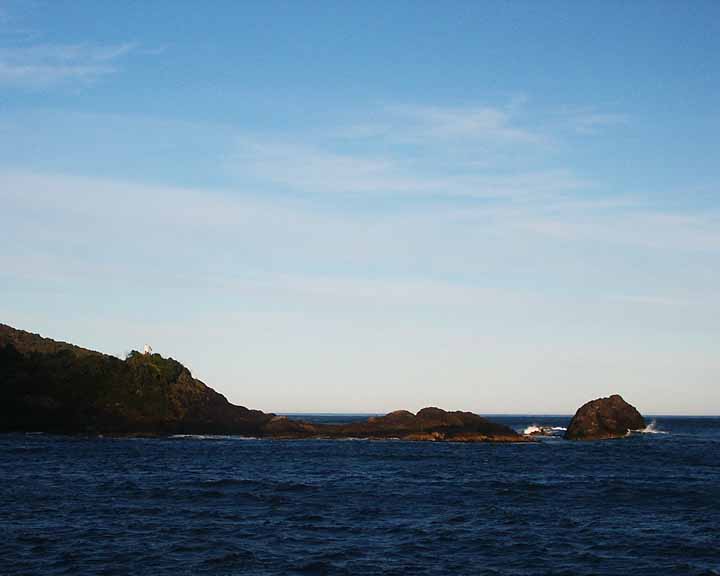
On the return our captain pulled in quite close
to the waterfall shown below for picture opportunities. As you can imagine, Roy took full advantage of
the opportunity. A surprising piece of information given was that this waterfall
is three times higher than Niagara
Falls. We, at first, thought that was just some Kiwi
bragging.
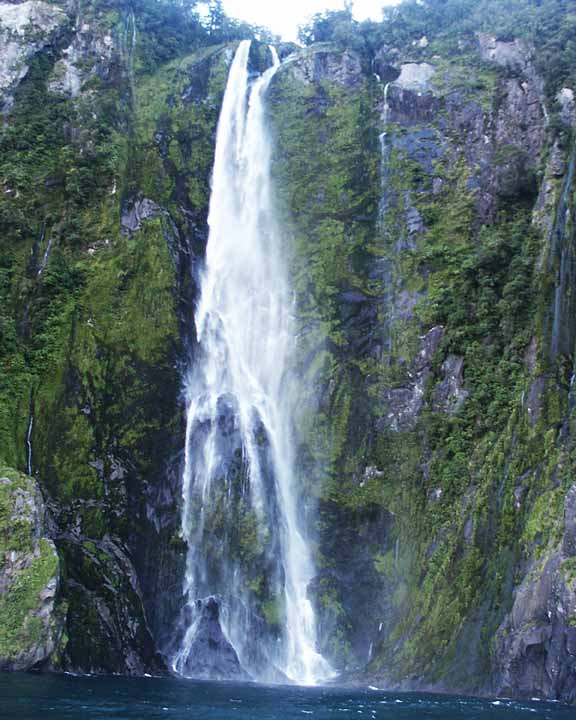
Then we turned around and looked at the
Princess Cruise Ship that had passed us. If you look very close in the center of
the picture below you can see it. Those cliffs are tall!!
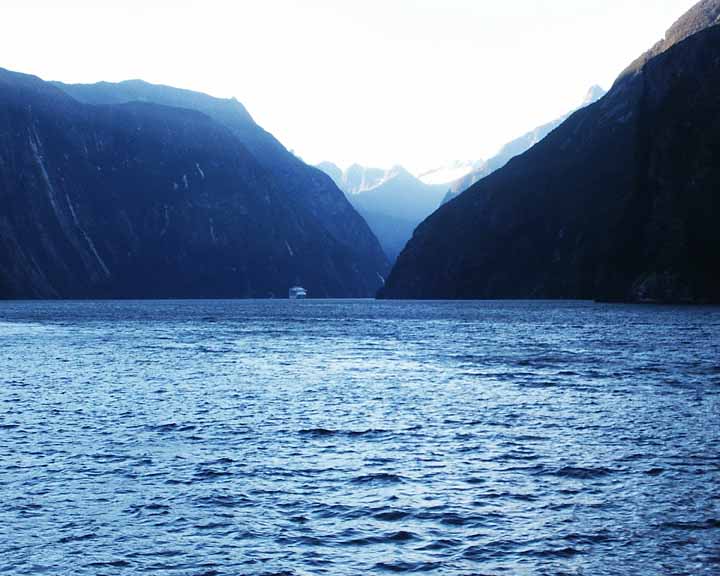
When the cruise ended, we traveled by bus back
to Queenstown. Along the way there was more of the "boring" scenery like that
shown below.
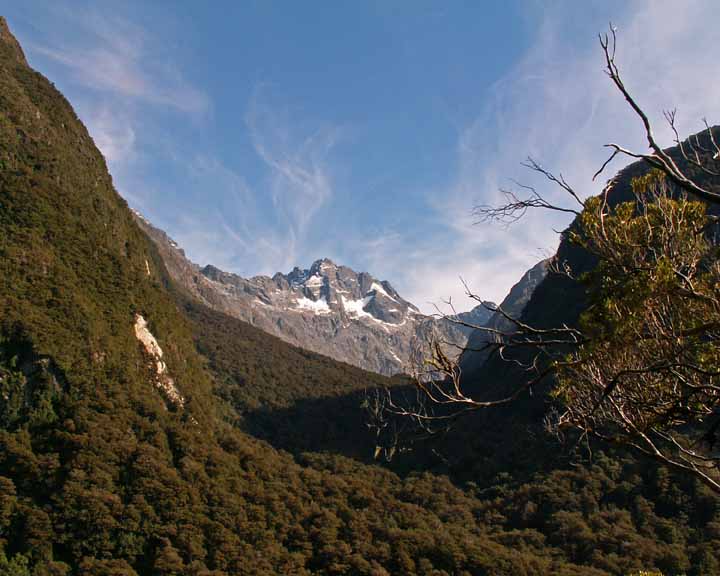
Once back in Queenstown, we walked in the
botanical garden and snapped more pictures of this beautiful area.
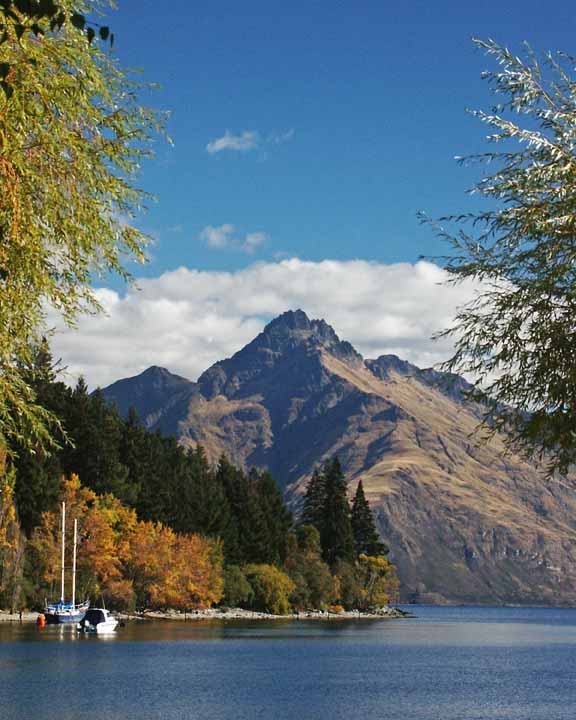
We had dinner by the water at a pleasant little
fish restaurant. It was the time for another sunset.
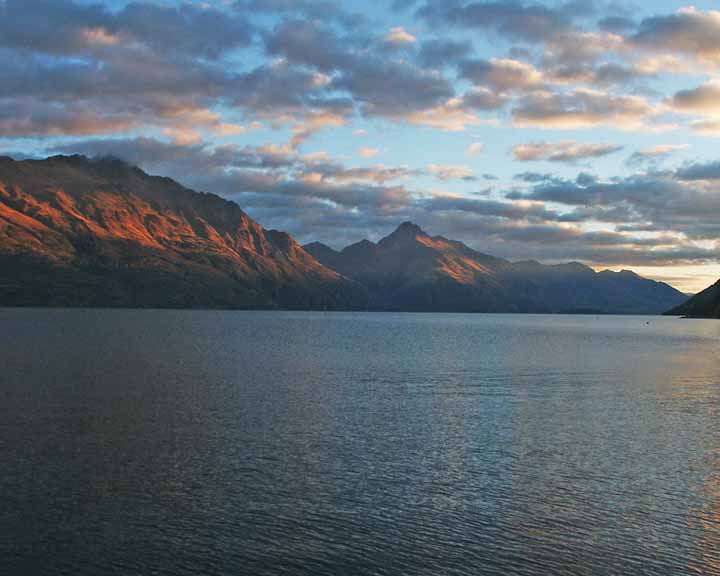
Roy
started working on pictures, but at 8 PM he decided he was just too tired and
knowing he'd be awake at 3 AM he went to bed. Pam lasted until about 8:15.
Day 27, Wednesday, March 29,
2006
Queenstown-Mount Cook.
This morning journey through the alpine scenery of
Mount Cook National Park
, named after the highest peak in New Zealand.
Weather permitting, don’t miss the chance to take an optional ski-plane flight
that actually lands on the 18-mile long Tasman Glacier. It is an unforgettable
experience. Dinner tonight is at your hotel. [B,D]
We slept until 6AM; I guess we had a "catch up
on sleep" night. It was time to leave Queenstown even though it was hard to
leave the view from our hotel window.
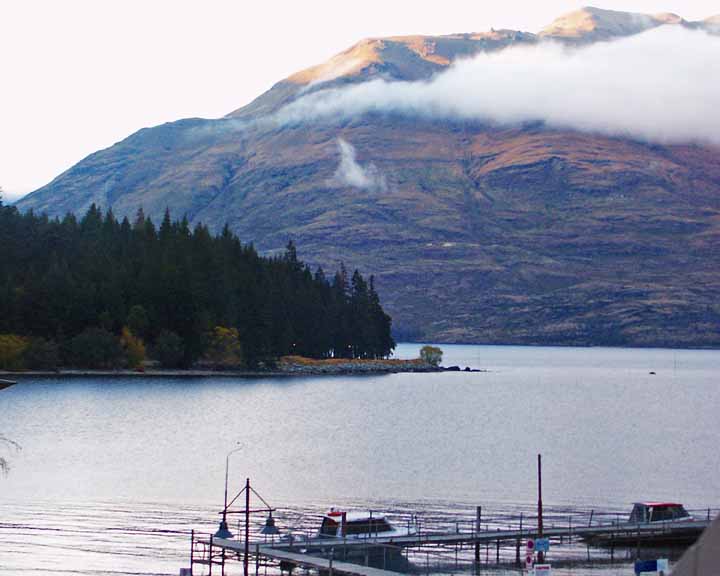
The clouds were doing interesting things with
mountain peaks in the morning before we left. Roy thought the shot below was dramatic.
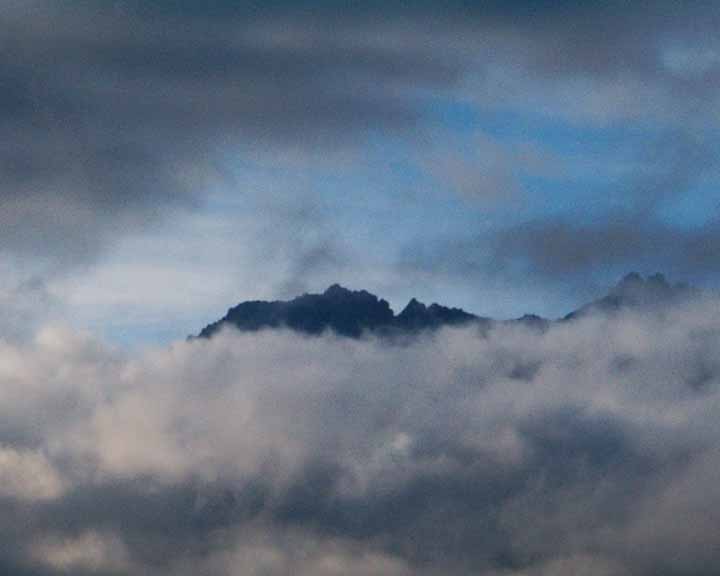
The bus ride toward Mount
Cook
was filled with beautiful scenery, similar to what we saw previously. It wasn't
until we started seeing Mount Cook that
Roy's camera trigger finger started getting twitchy. He
took many photos from the bus and generated some interesting shots because of
the reflections. We stopped before reaching the hotel for the night so that some
of our new friends could take a helicopter ride up to the Tasman Glacier. That
resulted in Roy burning more electrons
taking pictures of the mountains. One of them is shown below.
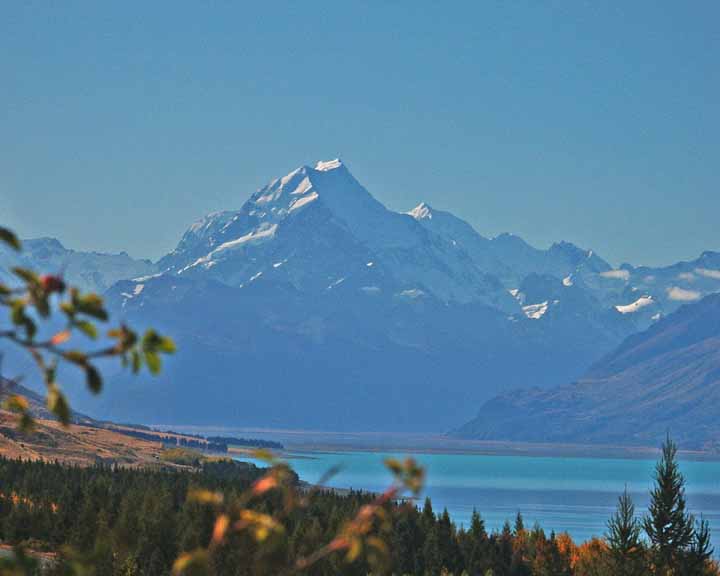
It wasn't too long after that we reached our
hotel. The view out our window was beautiful this morning in Queenstown but so
was it this evening as can be seen below.

We took a walk on a short trail. It was
supposed to take twenty minutes round trip. Nobody mentioned that it was
practically straight up. (Well, not really, but at the elevation we were at it
seemed to be.) It did result in a picture that
Roy
liked.
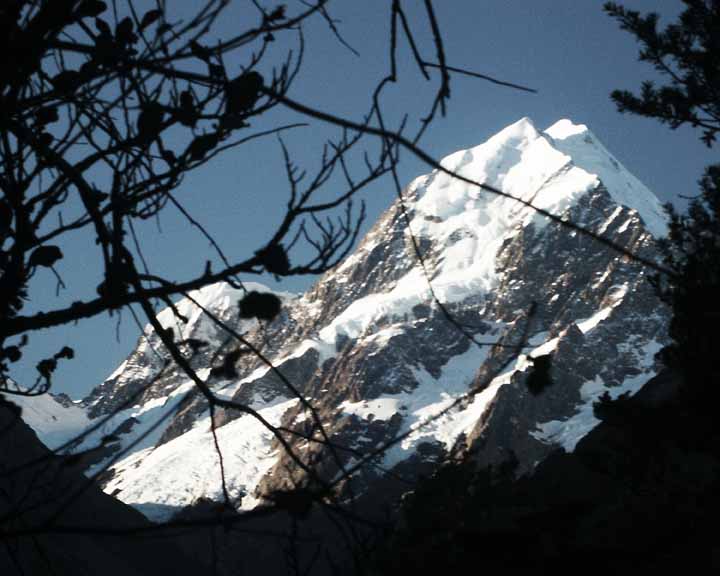
The tour group enjoyed a delicious buffet
dinner. Then it was time to head back to the room for the night.
Day 28, Thursday, March 30,
2006
Mount Cook-Christchurch.
Leave this alpine wonderland, ringed by 17 permanently snow-capped peaks, and
drive to Lake Tekapo to view the Church of the Good
Shepherd. Then cross the patchwork Canterbury Plains to reach
Christchurch, the “Garden City” of
New Zealand. [B]
We awoke this morning and peaked out our window
to see another inspiring view of Mount Cook.
Instead, we saw fog. We couldn't see ten feet from our window. Fortunately, the
fog lifted enough so that our coach driver could safely get us on our way. It
wasn't until we were on our way that we learned how lucky we were to get the
weather we had the day before. One of our group had been talking to a young
person from the night before. The youngster (it's all relative - supposedly in
their 20s) had now been to Mount Cook four
times and yesterday was the first time she saw it. Previously, if it wasn't
foggy, like this morning, the mountain top was covered with clouds.
With the fog finally giving way to heavy
clouds, the drive was uneventful. We did stop after "morning tea" to view the
Church of the Good Shepherd. It is a non-denominational church with a large
picture window behind the altar.
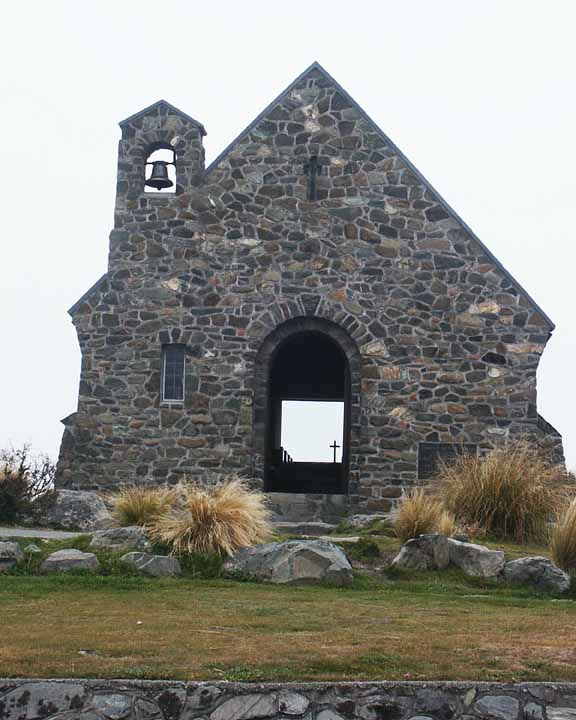
We thought the small stone church was quaint
and cozy, but the view out the front window was not all that spectacular. Later
on we found a post card at our lunch stop of what the view looks like without
the clouds. (You'll have to take our word until we get home and scan the
postcard. We wonder how the parishioners are able to stay focused on the
sermon.)
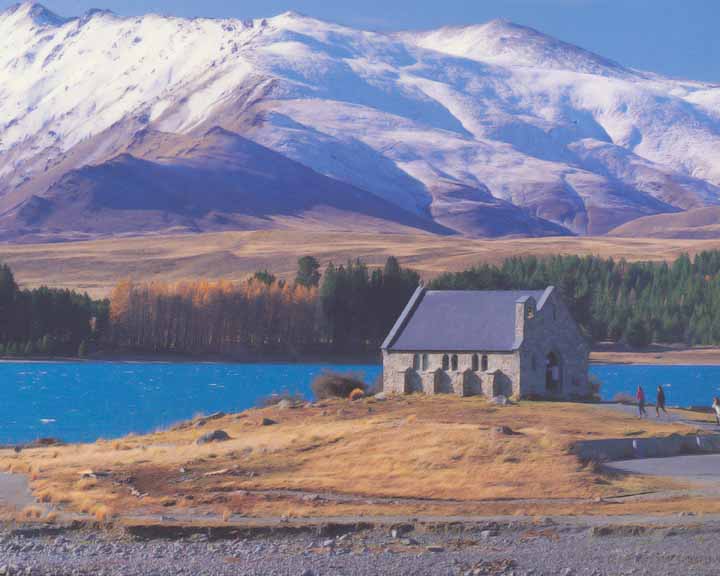
(from postcard)
After taking a brief ride around Christchurch to get our bearings, we arrived
at the hotel about 2:30. After taking a little time to settle in, we took a walk
around the city. Much of the city is centered around Cathedral Square, the sight of an
impressive Anglican Church.
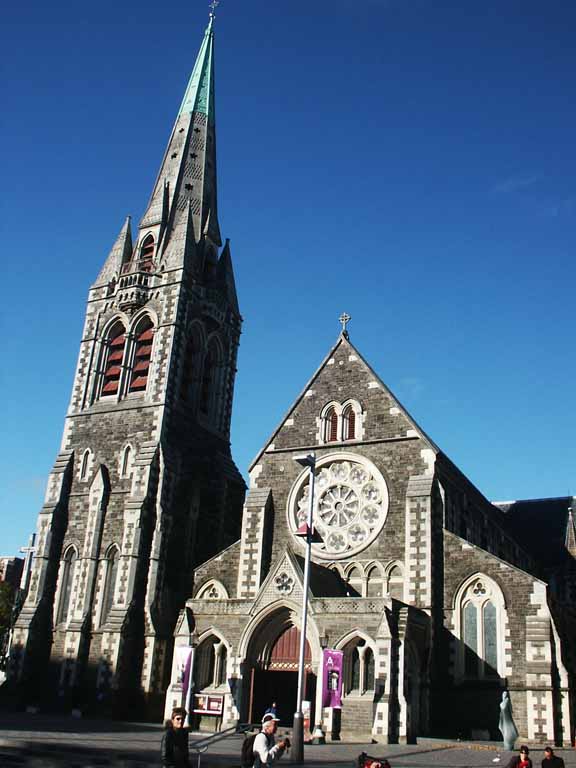
Dinner tonight was on our own at the "Sticky
Fingers."
Day 29, Friday, March 31, 2006
Christchurch
Sightseeing starts with a drive up the winding Summit Road for views of
Lyttleton Harbor, then past Christchurch’s old stone buildings, the charming
Avon River, and acres of green parks. The remainder of the day is free to
explore this beautiful English “Garden City.” This evening your Tour Director
hosts a FAREWELL Dinner, the perfect finale to a great touring adventure. [B,D]
We were on the bus at 9 AM for more of the city
tour. First stop was a huge rock on a beach. Some of the group climbed to
the top. We thought the following picture was rather amusing. It seems that the
U.S.
isn't the only place where the laws that are followed are rather selective.
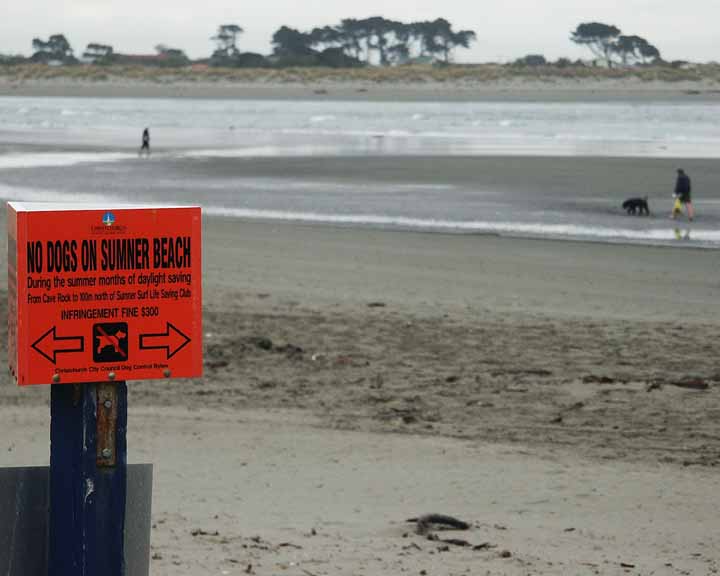
After seeing a number of other sights in the
city, we stopped at the museum and botanical garden. We were given the option of
coming back to the bus in an hour or making our own way back to the hotel. The
museum looked so interesting that we doubted we would see enough of both in an
hour so we opted for making our own way back to the hotel (only a matter of a
few blocks).
The museum was very interesting. Christchurch is the jumping off city for most
Antarctic scientific expeditions. The museum had a rather large section devoted
to the history of those explorations. We've all read about and seen movies
depicting the conditions of Antarctica. When
you see some of the equipment of the early explorers, you have to wonder how any
of them survived.
The botanical gardens were beautiful.
Unfortunately, this was one of the few days on our trip that remained cloudy all
day. For Roy, cloudy days usually
mean he doesn't get the kind of pictures he likes. However, close-ups of flowers
are not dependent on bright sunshine. He found the flowers below to be unique.
Their common name is the Celtic Cross.
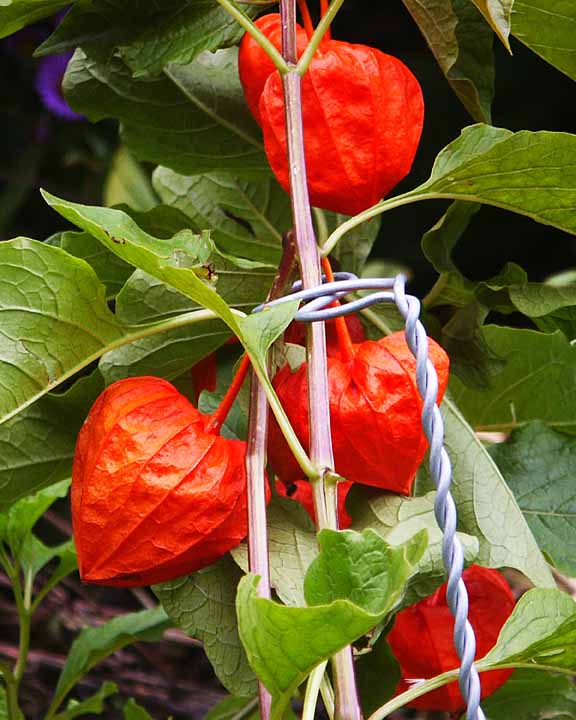
After wandering the gardens for a considerable
length of time, we decided it was time for lunch. We found a pub style
restaurant close to the hotel and had a nice meal. For those of you who don't
know what a pub style restaurant is (we didn't), you order your meal at the bar,
they give you a number for your table, and the meal is brought to you when it's
ready. They seem to be quite popular in both
Australia
and New Zealand.
After lunch, we headed back to the hotel to
start putting things together for the trip home. In so doing, we got involved in
a movie on TV. We were a little disappointed in ourselves, spending our last
afternoon in New Zealand
in a hotel room, but we were kind of worn out.
The evening dinner was hosted by our Globus
guide, Karen. It was a nice time to say goodbye to all of our new friends. In
doing so, we had a good chuckle over the number of people who ended up watching
the same movie in the afternoon.
Day 30, Saturday, April 1,
2006
This afternoon board your homebound
flight which arrives the same day. [B]
Contrary to the description above, we did not
board our homebound flight in the afternoon. Because we had used frequent flyer
miles, we had different arrangements. We had to board a shuttle to the airport
at 4 AM. Of course, much to our delight, there was our Karen not only seeing us
off but making sure we had a box breakfast. The 4 AM may have been a little
earlier than needed, but it did insure that we were there the required extra
time for an international flight. The flight from
Christchurch
to Sydney was
nice and uneventful. We had about a seven hour layover in Sydney.
Roy
was disappointed that the shopping was not as good as he had remembered from his
previous visits, but we did find enough things to spend the last of our
Australian money.
The flight to
Los Angeles was as expected, long and uneventful. Once
again, Pam reiterated a number of times that she liked the extras that come from
flying in business class. We were able to get some sleep during that flight.
In
L.A.
the trip through immigration and customs went very smoothly. We were standing at
our gate about five minutes before boarding time, when Roy noticed Hill and Sarah, two of our new
friends coming down the corridor toward their flight to the east coast. They had
left in the afternoon, but had gone from Christchurch
to Auckland to L.A. All we had time for was a quick hello,
and some more of the goodbyes we said the night before.
Roy
did see an attractive view when flying over the west. He doesn't know what
mountain it is, but thought it looked neat.
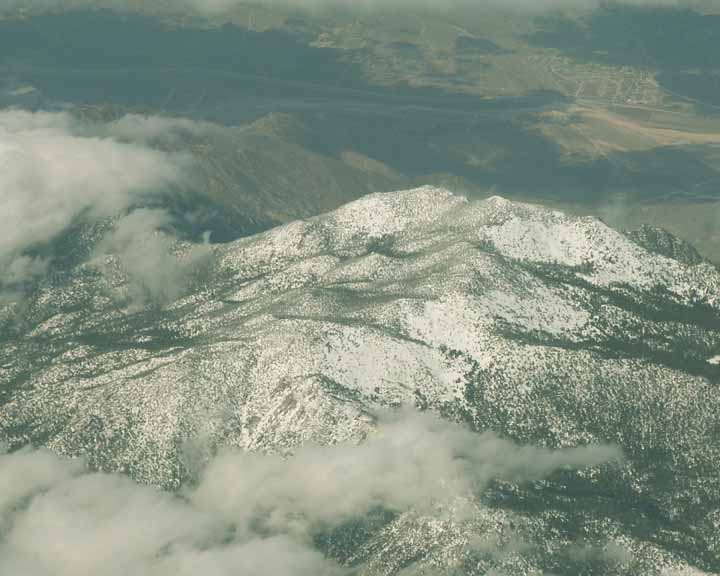
And there was one more sunset to photograph.
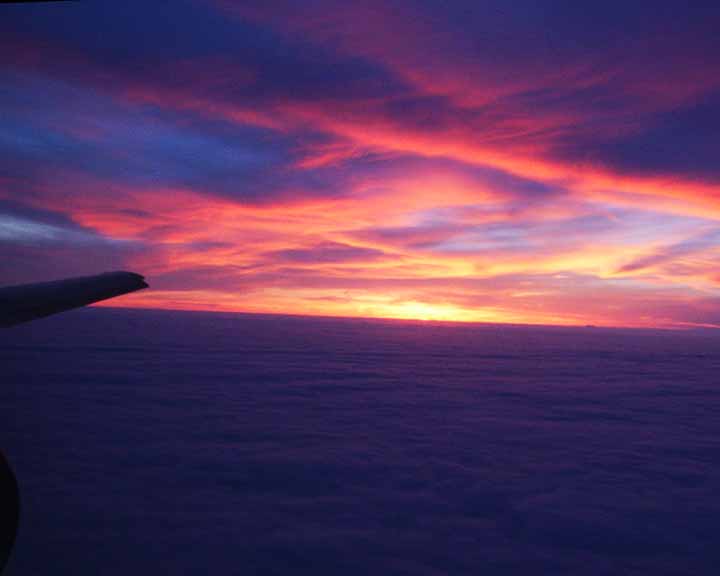
Arrival at O'Hare was on-time; baggage seemed
to take forever, but really wasn't that long. As had been previously arranged, a
call to Paul and Maxine Palmer led to our meeting at the Kiss-and-Fly for the
drive home. We arrived home about 8 P.M. It was still April 1st as it was when
we left New Zealand,
but it was almost 35 hours after we waved goodbye to Karen.
What a great
adventure/trip/vacation/experience/holiday/ or whatever you want to call it!
Hope you enjoyed the journal.
Back to
travel page




















































































